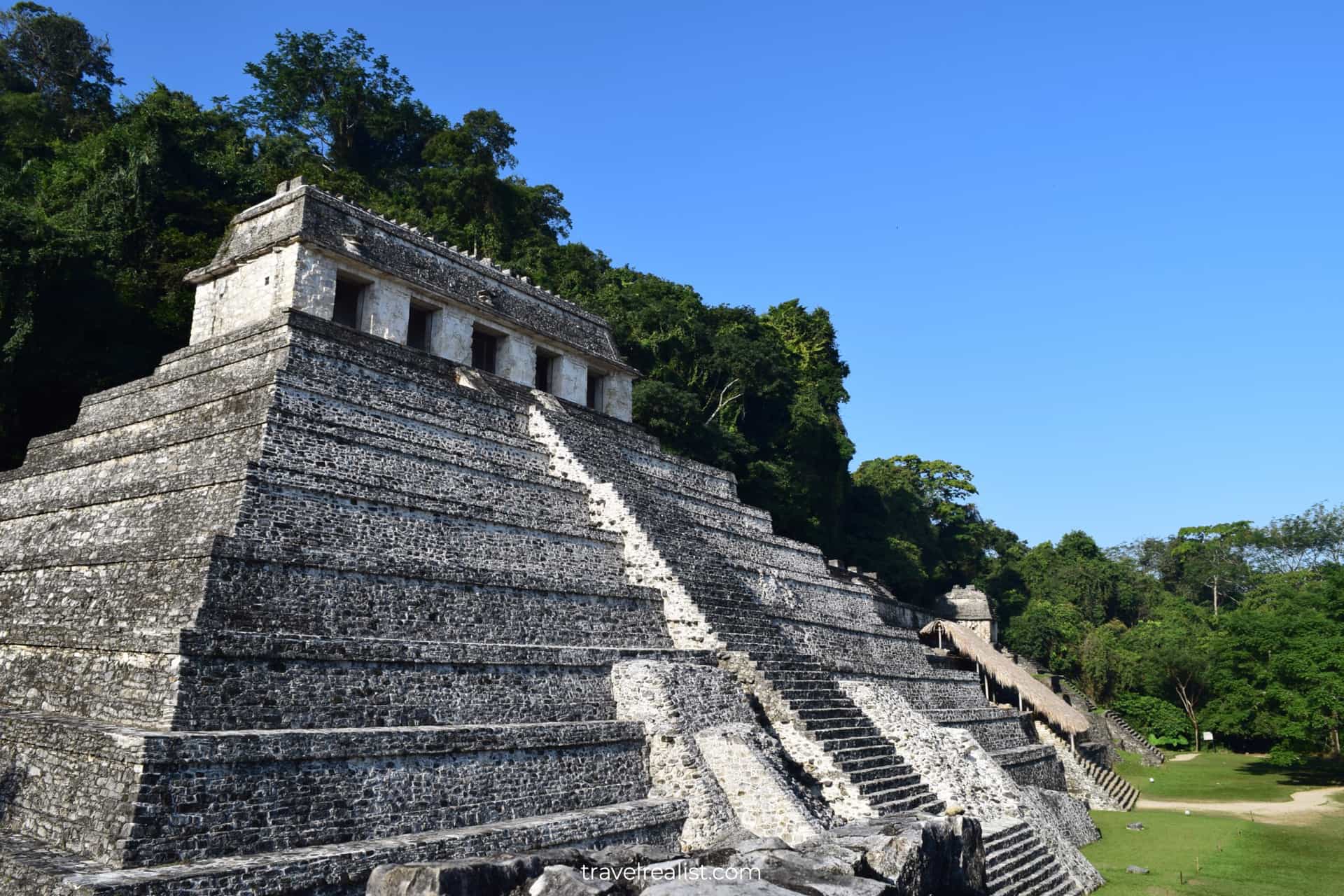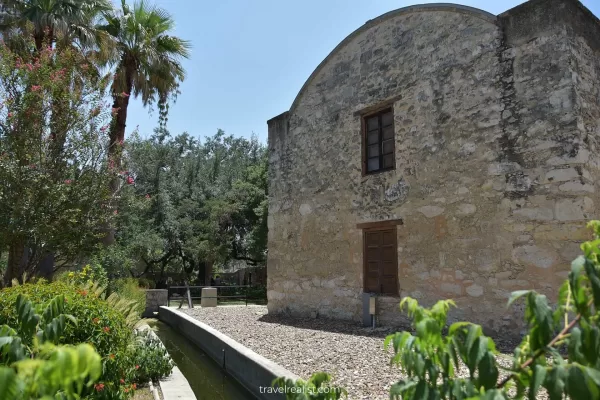Garfield Park Conservatory Chicago: An Oasis
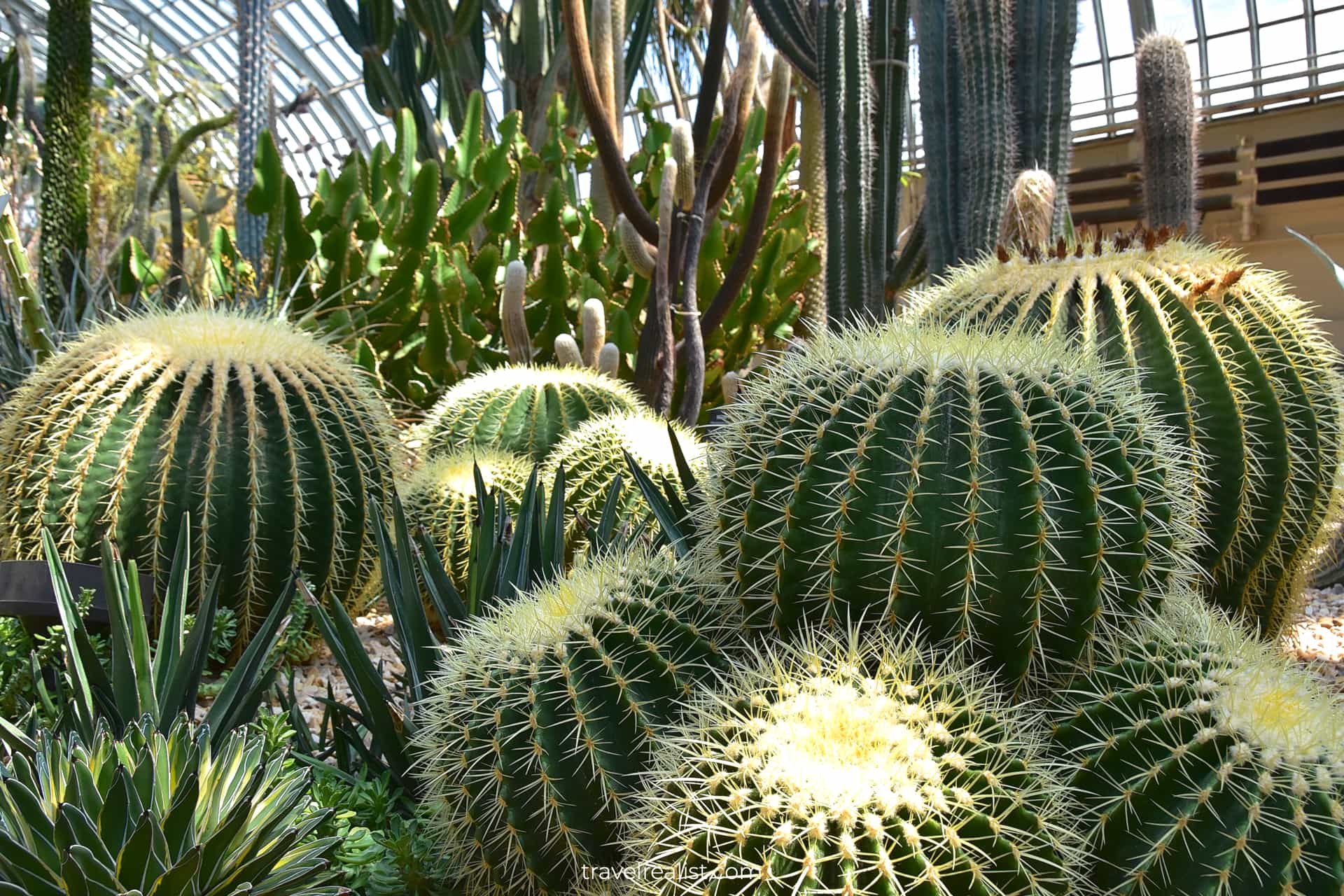
This realistic Garfield Park Conservatory Chicago Guide helps you plan your next adventure in this greenhouse.
The Garfield Park Conservatory is a greenhouse in Chicago, Illinois. It is one of the largest covered botanical gardens in the United States.
This post includes affiliate links that will earn us commission if you make a purchase via these links.
Sights & Places of Interest
The Garfield Park Conservatory dates back to the 19th century. The current greenhouse building was constructed in 1907. It aimed to be the largest single roof greenhouse in the world.
The conservatory is an architectural masterpiece with an astonishing variety of plants. Together they make the Garfield Park Conservatory a real highlight on a trip to Chicago.
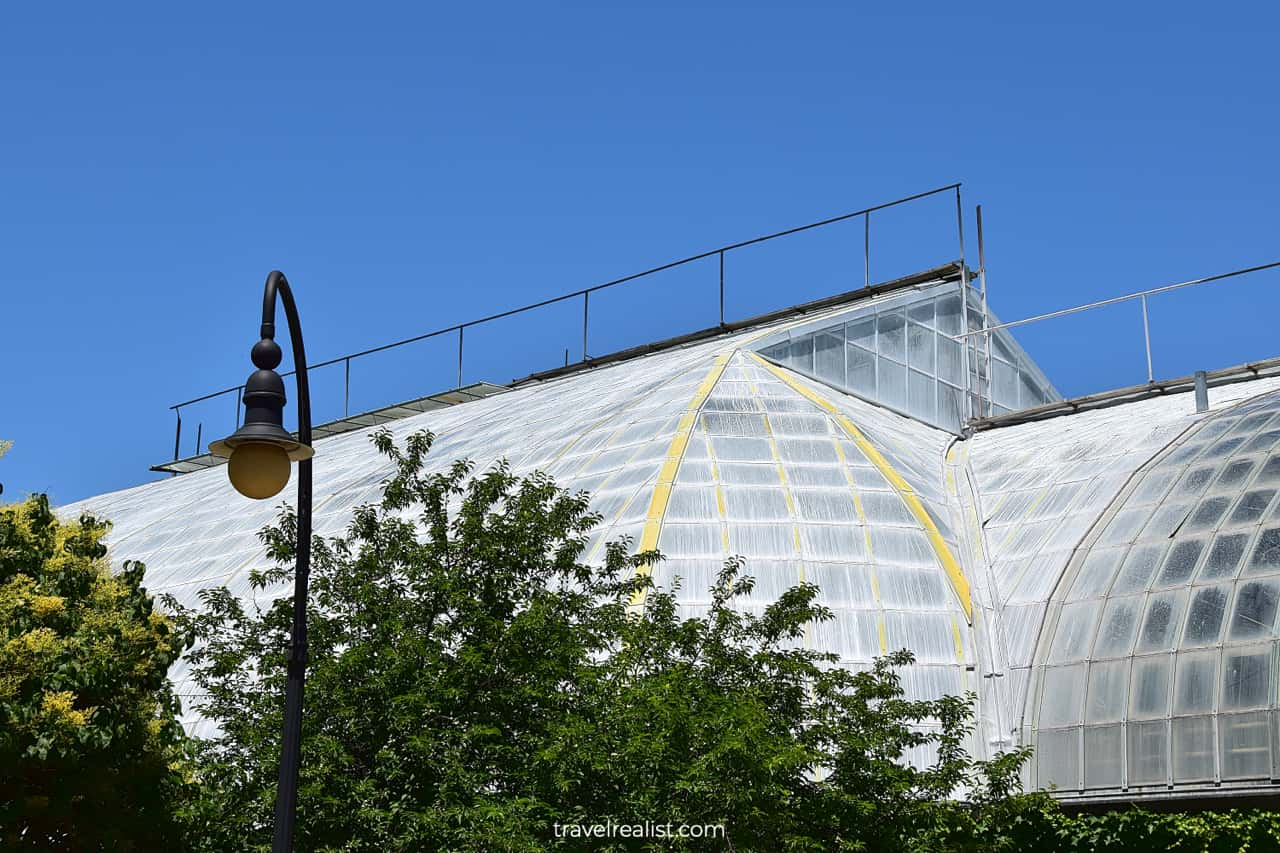
You might not think of Chicago as a destination for greenhouses and gardens. Its northern climate has to make it difficult to grow exotic plants, hasn’t it? In this case, you are about to have your mind blown away.
Some of the most beautiful US gardens are in the Northern United States. Both Garfield Park and Lincoln Park Conservatories are in Chicago. International Rose Test Garden is in Portland, Oregon.
Garfield Park is no Griffith Park in Los Angeles, Balboa Park in San Diego, or Central Park in NYC. But the conservatory puts this park on the map.
This Garfield Park Conservatory Chicago Guide documents a visit to this greenhouse. It walks you through the main rooms and calls out some of the most exotic plants.
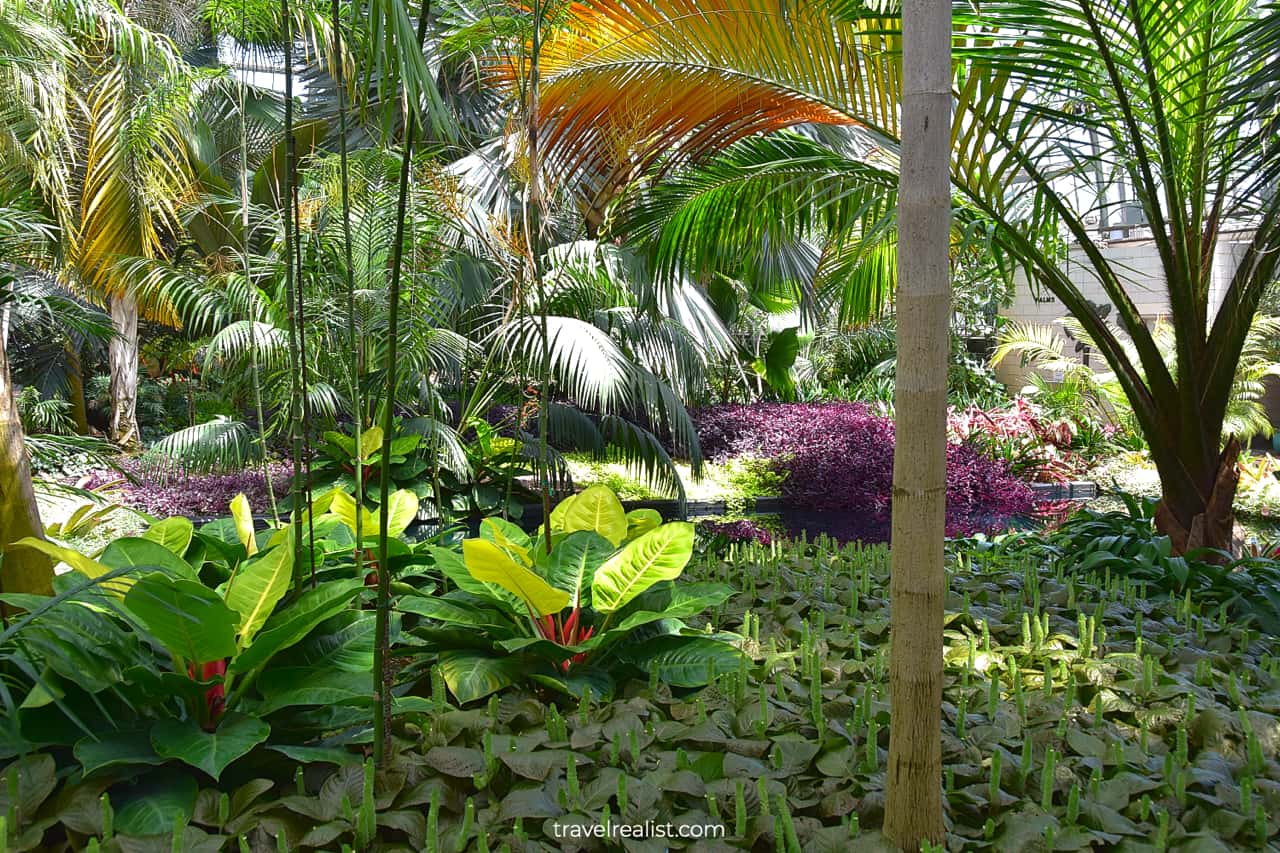
1. Palm House
As soon as you check in and enter the greenhouse, you will find yourself in the Palm House. It is the largest chamber in the Garfield Park Conservatory.
The Palm House also has the highest ceilings in the entire conservatory. Its dome glass ceilings both let a lot of light and accommodate the tall palm trees.
The Palm House has a loop walk arounds the greenhouse. There are two short trails that allow you to cut a corner or go through to the other side. Conservatory staff might close these trails at their discretion.
You could choose to explore the Palm House in any direction. This Garfield Park Conservatory Chicago Guide follows a counterclockwise path.
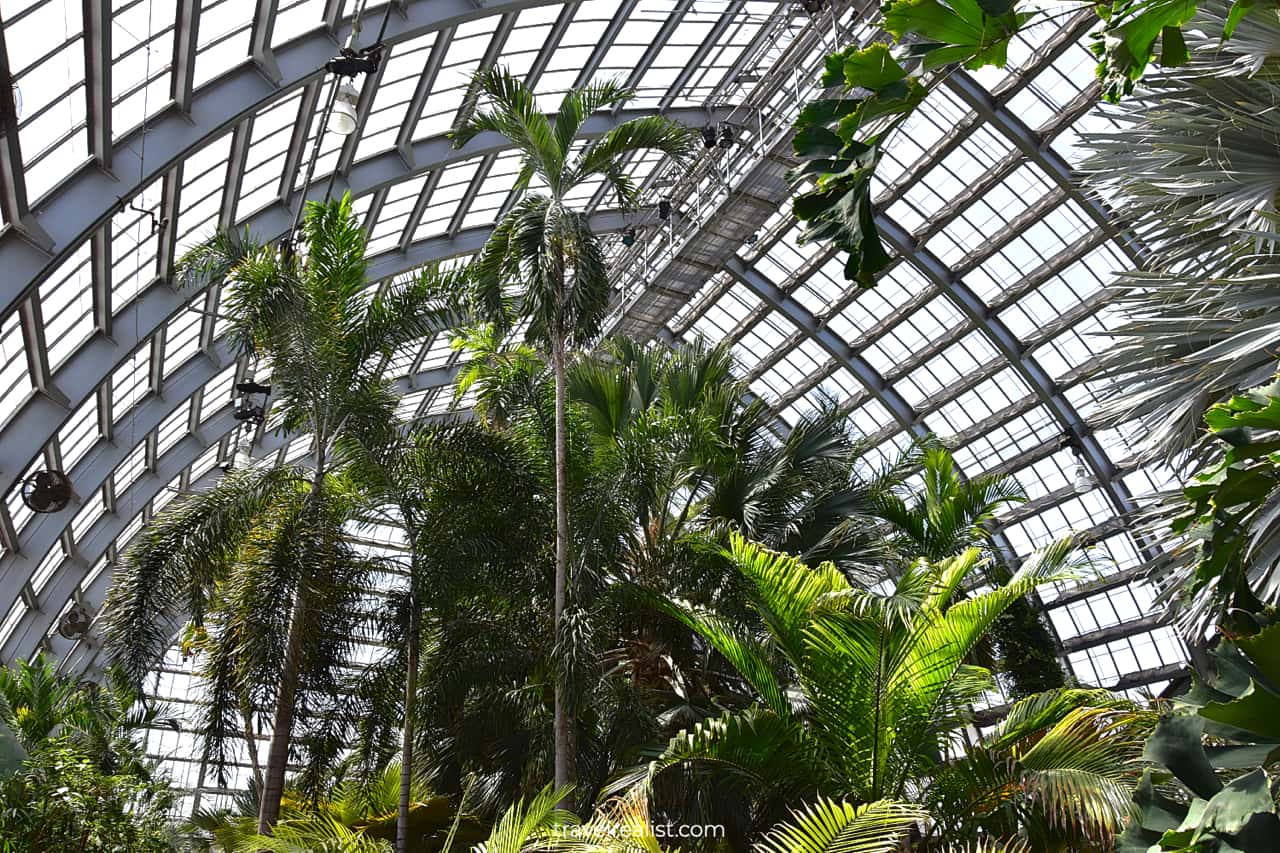
1.1. Scheelea Palm
The Palm House displays over 80 different palm varieties. It might feel like a drop in the ocean since there 2,700 palm tree types in the world.
But remember that these palm trees all grow in the harsh northern climate of Chicago, Illinois. Snow, wind chills, and average low temperatures of 22°F (-6°C) do not make this task any easier.
It is quite difficult to maintain the right temperature and humidity conditions to growth palms and other tropical plants indoors. As a result, 80+ varieties is a very impressive achievement.
Take Scheelea Palm as an example. It is not an easy tree to grow. This palm originates in Amazonia in South America. The temperatures in that region stay between 65°F (18°C) and 90°F (32°C) year round.
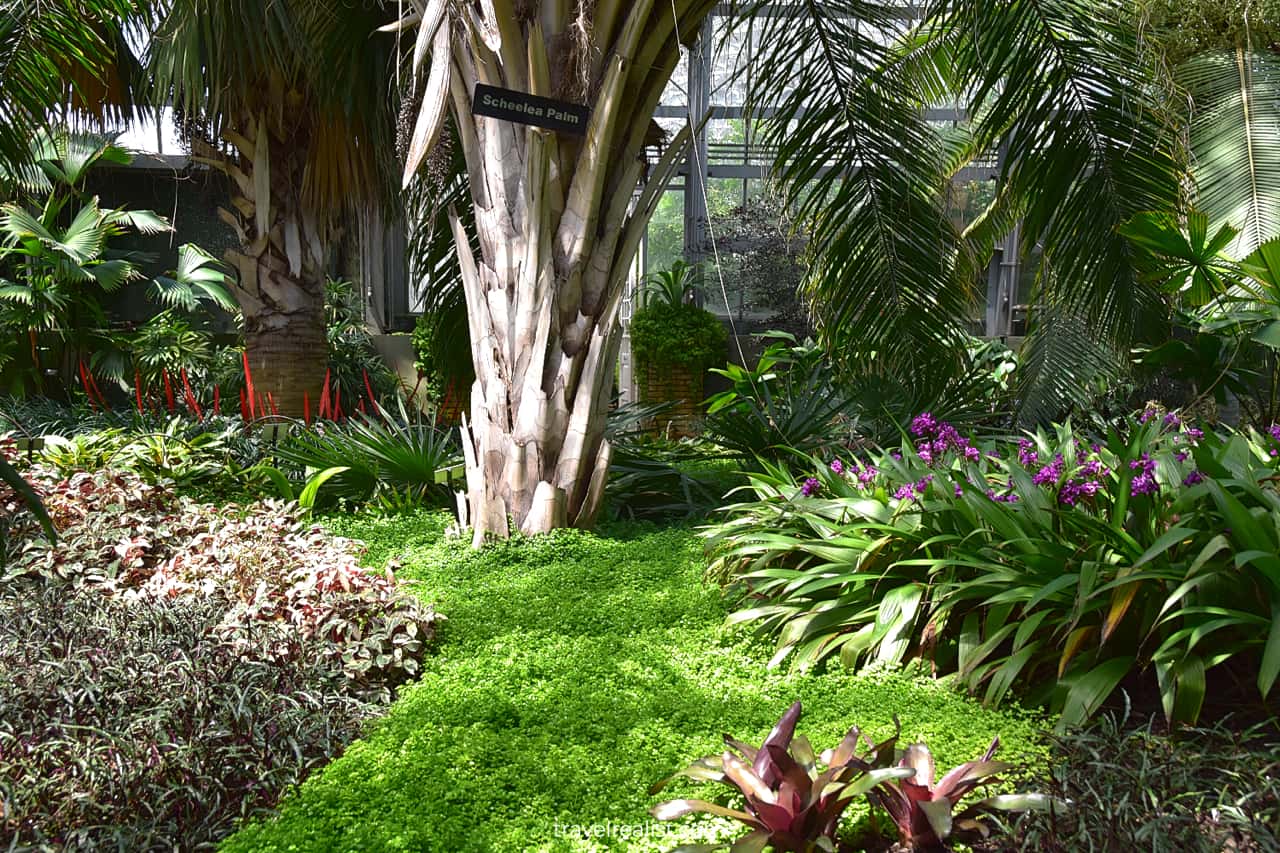
1.2. Calathea
There are countless tropical plants that grow right next to the palm trees in this greenhouse. Calathea is the larger plant of this group. It is easy to believe that growing it at home is a walk in the park.
Well, think again. Calathea is a very temperamental house plant. Like other plants, it does not tolerate underwater and overwatering. But finding the right balance is a real challenge with Calathea.
This plant is also very susceptible to temperature changes. You would have to keep it in the warmest spot in your house in the winter. And even if you get everything right, this plant might still fail to survive.
Its leaves would curl if the plant does not like the indoor temperature. But you will be rewarded if you manage to create the perfect conditions for Calathea. Look for the fully open multicolored leaves.
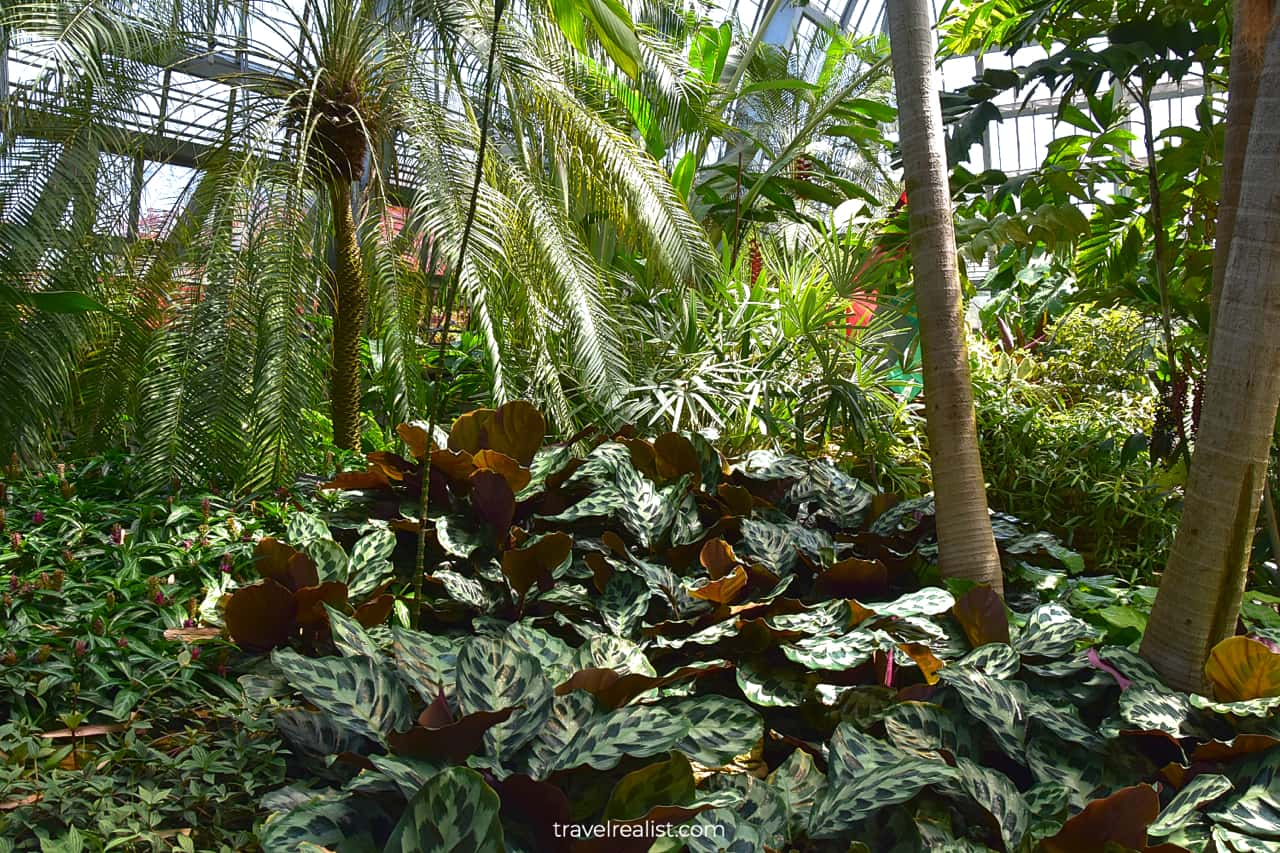
1.3. Nerve Plant
The next few areas of the Palm House have a handful of smaller plants. Most of them grow right next to one another. As a result, they create a lawn or a living carpet.
Take a look at these beautiful nerve or mosaic plants. They originate in Latin America. These plants got their name from the visible white and red leaf veins. The plant leaves are of dark green and pink color.
You have likely seen these plants before the Garfield Park Conservatory. This is hardly a surprise. Nerve plants are a common houseplant. But they need high humidity and temperature to thrive.
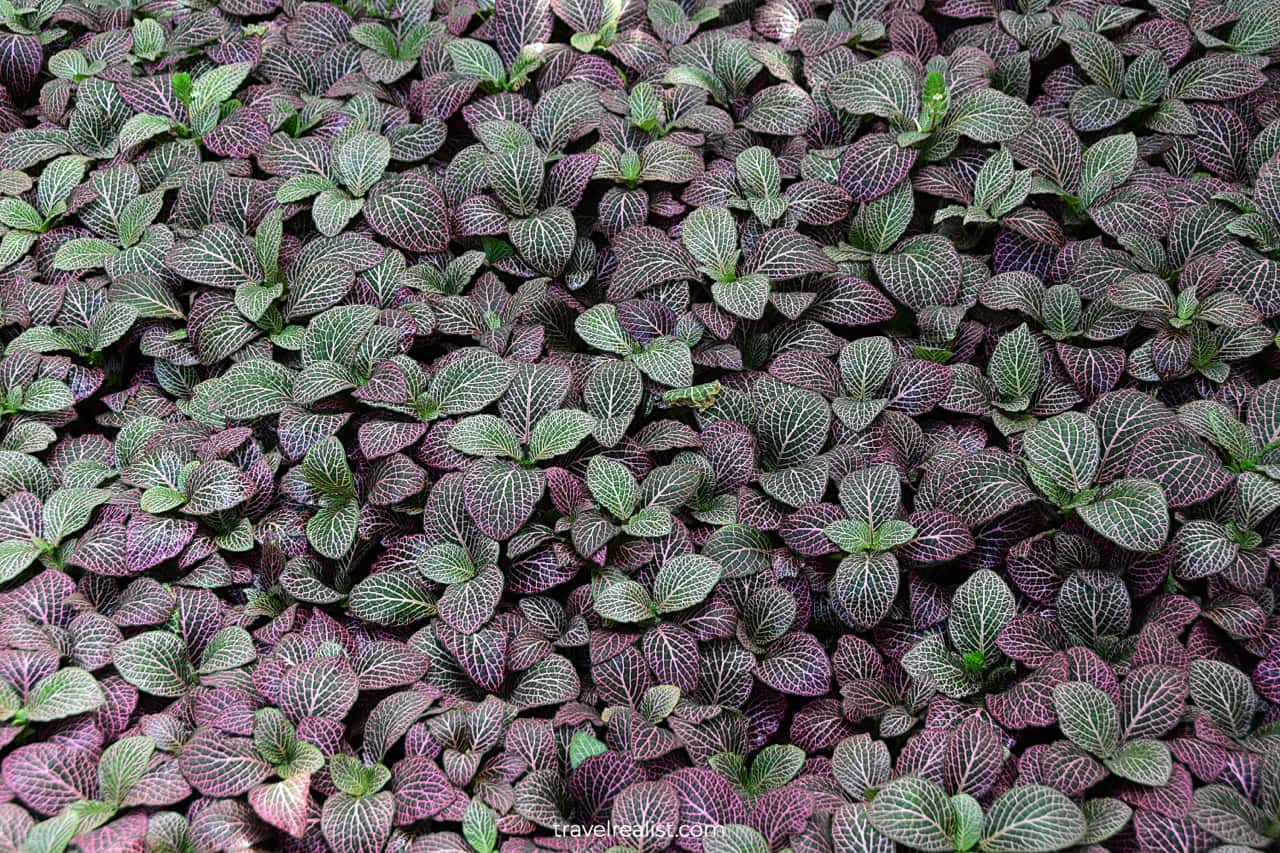
1.4. Pilea Baby Tears
Pilea Baby Tears is the next plant that could get your attention. This trailing plant has delicate green leaves. And these leaves gave Pilea its poetic name.
You might think that Pilea Baby Tears is a grass. You would be wrong. While it is hard to see the vines, Pilea is closer to ivy than it is to grass.
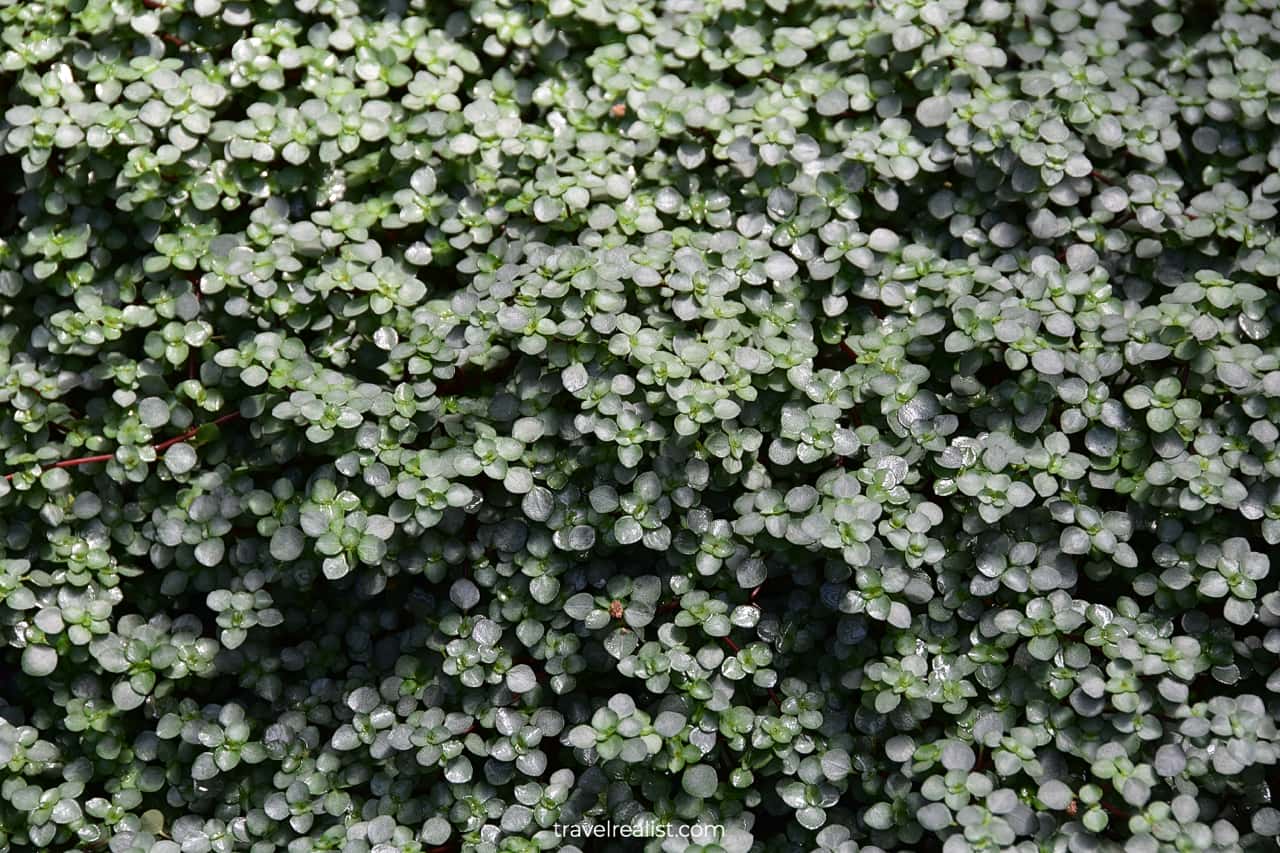
1.5. Basket Grass
As you continue your walk around the palms at the Palm House, you will see new plants nearly every minute. Basket Grass, or Oplismenus Hirtellus Variegatus, is a tropical plant that grows in the wetlands.
Basket Grass might be less stunning than other tropical plants until it blooms. But it is still a great addition to the Palm House in the Garfield Park Conservatory.

1.6. Ruffled Fan Palm
You could stand in the shade of a ruffled fan palm if you visit the conservatory on a sunny day. This palm tree has large leaves with a distinct ruffled pattern.
It originates in Vanuatu, a small island country in the Pacific Ocean. Vanuatu is far closer to Papua New Guinea, New Zealand, and Australia than to Hawaii.
Thanks to the Garfield Park Conservatory, you could see this beautiful plant without needing to travel across the world.
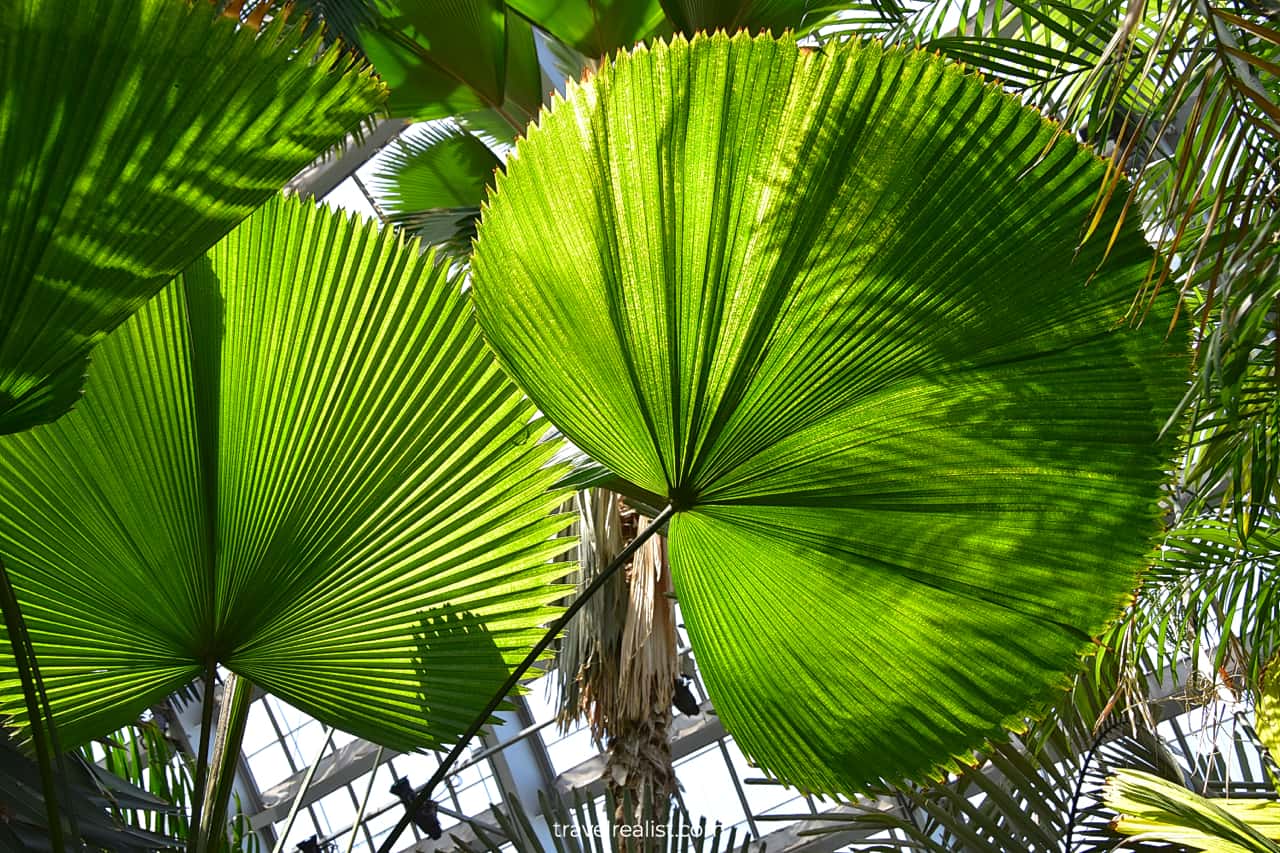
1.7. Flaming Sword Bromeliad
You will notice bright red offshoots near a few of the palm trees. They grow from a plant with zebra like color pattern on its leafs.
Wait till you hear the name of this plant. It is Flaming Sword Bromeliad. There could not have been a better description of this plant, could it?
Flaming Sword Bromeliad also originates in Latin America. But it is another common house plant nowadays. It prefers bright indirect sunlight and high humidity.
This plant is in the same family as your ordinary pineapple. And, not unlike a pineapple, Flaming Sword Bromeliad is not toxic.
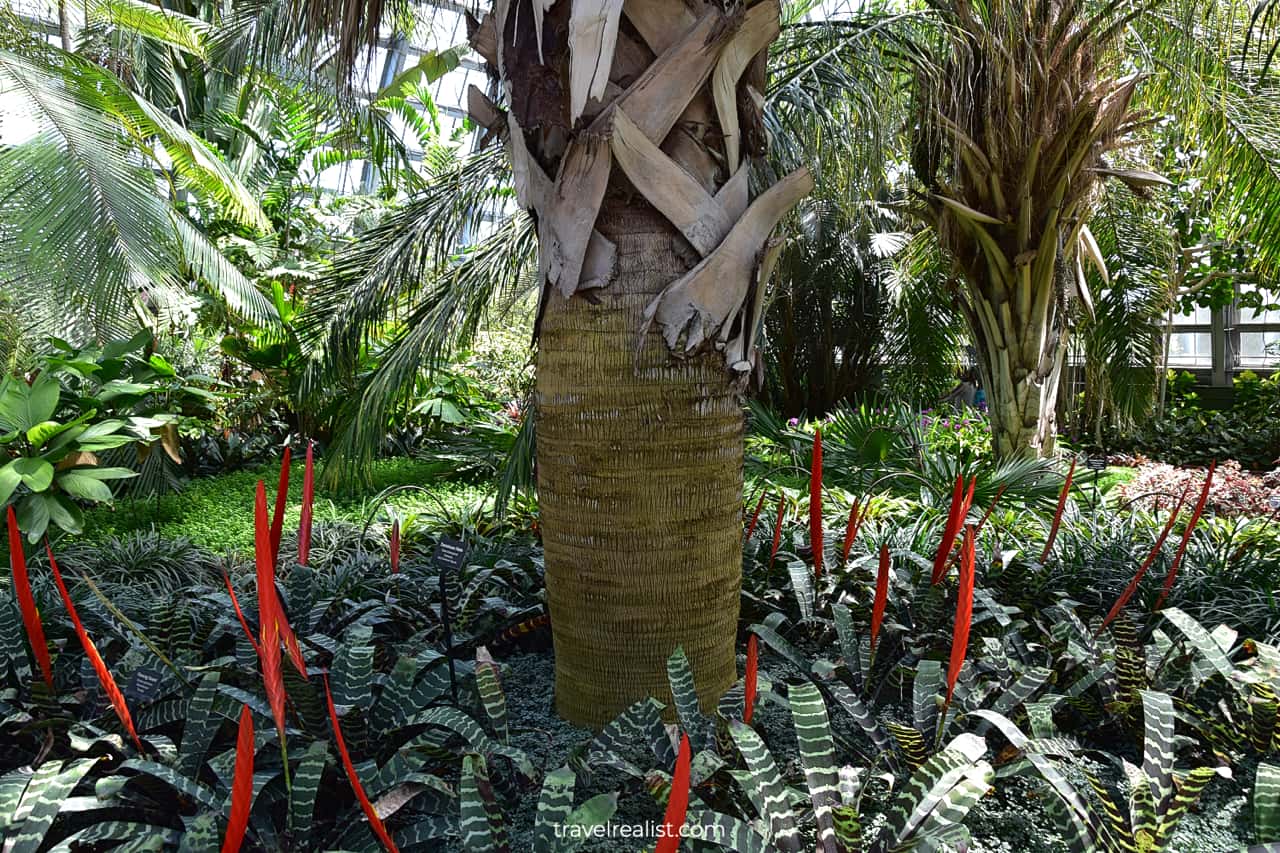
1.8. King of Bromeliads
A King of Bromeliads is a natural next plant to study in the Garfield Park Conservatory. This plant is similar to a Flaming Sword Bromeliad. Only a shade of green and a missing flaming sword set them apart.
A King of Bromeliads came from Brazil and prefers high humidity. It grows long leaves that could reach up to 3 ft (1 m) long. A mature plant is quite a bit bigger than other bromeliad plants.
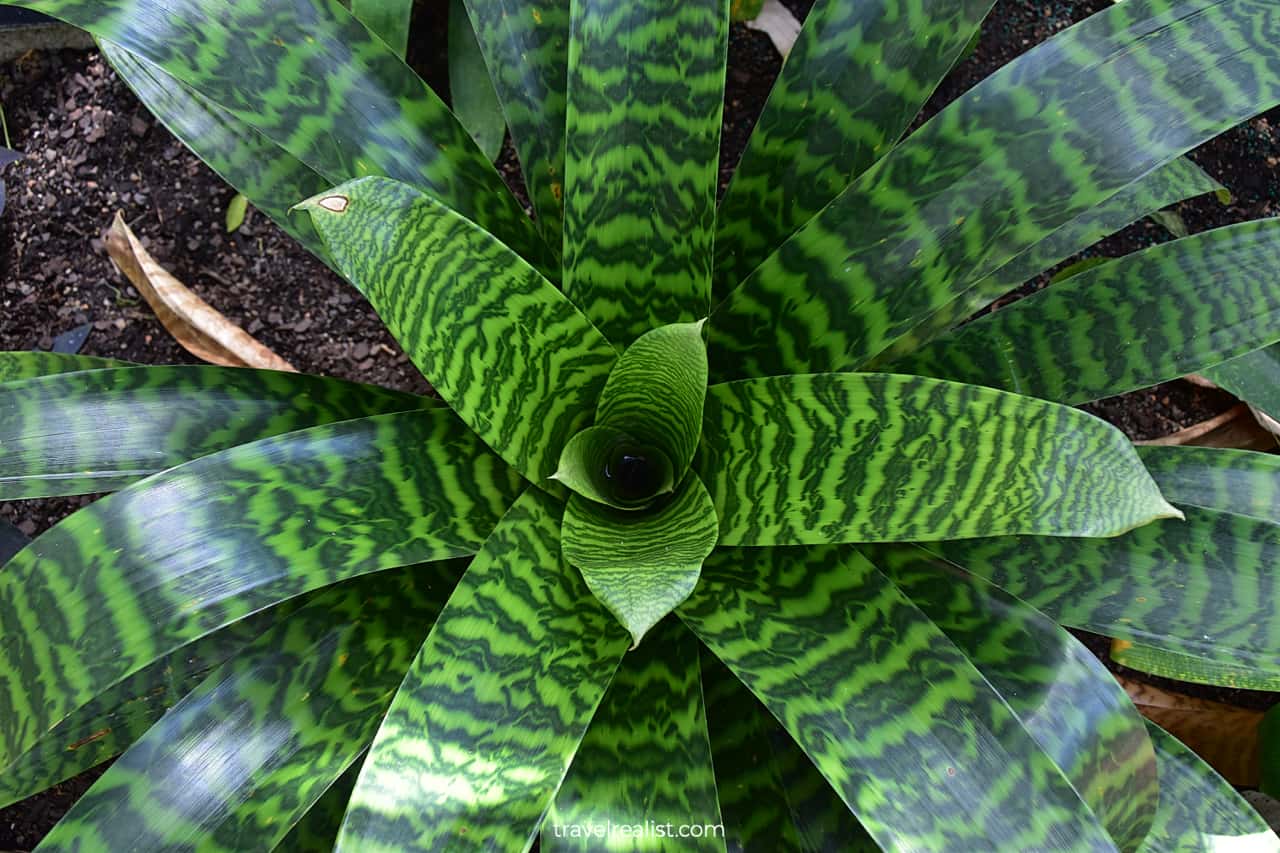
2. Fern Room
You could easily spend 20 to 30 minutes studying the plants in the Palm House. Once you finish your exploration, you could proceed to the Show House or the Fern Room.
The Fern Room might be a better option. This central greenhouse has a gable roof. Its ceiling is slightly lower than the Palm Room since most ferns do not reach palm heights.
There is another loop walk inside the Fern Room. As with the Palm House, you could explore the loop in any direction.
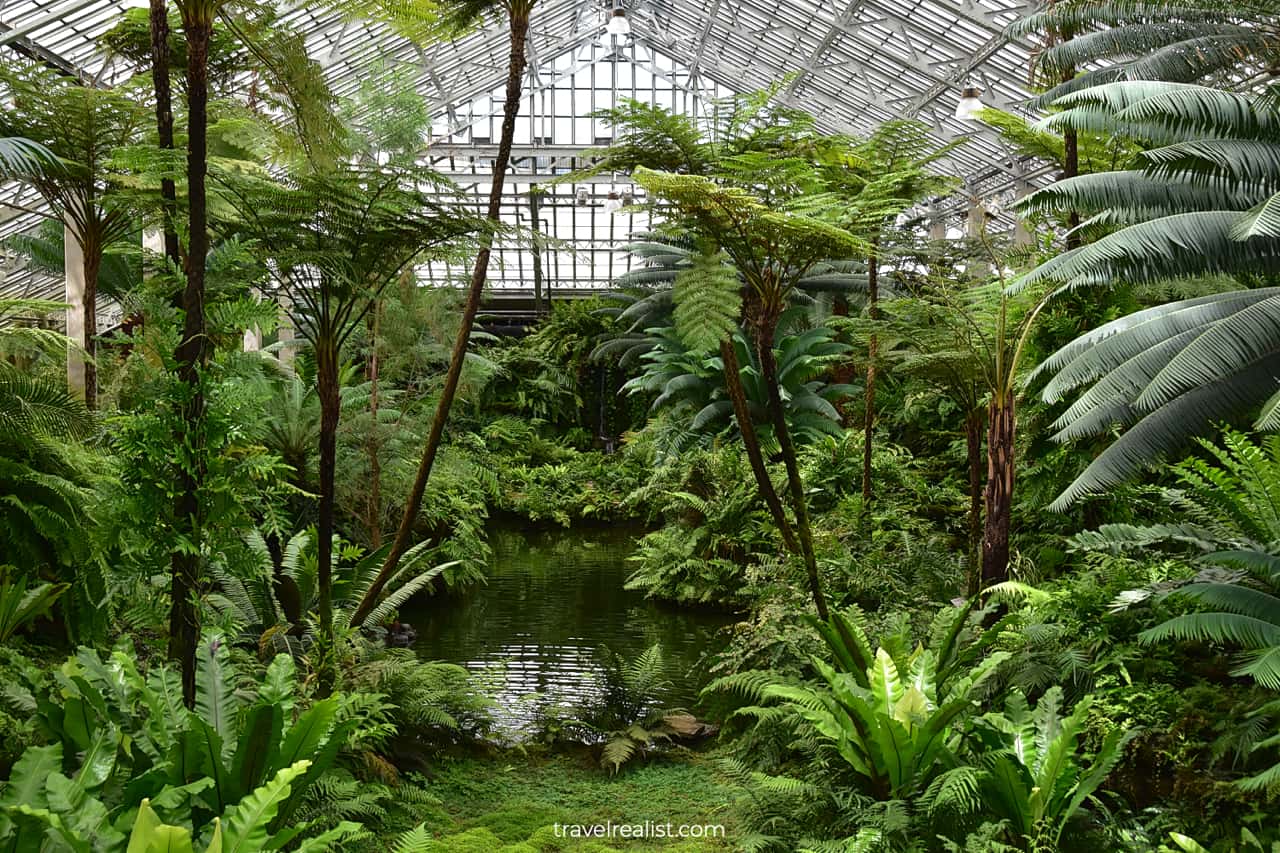
2.1. Indoor Pond
The indoor pond is going to be the first thing you notice in the Fern Room. This shallow pond is quite large. It takes about a third of the Fern Room by area. It is large enough that there are fish in this pond.
But do not expect to see catfish or bass there. Garfield Park is not Silver Springs or Rainbow Springs in Florida after all. Giant koi fish are the species present in this indoor pond.
These fish are a common sight in human made ponds. You can find them all over the United States, from Alamo in Texas to Biltmore in North Carolina.
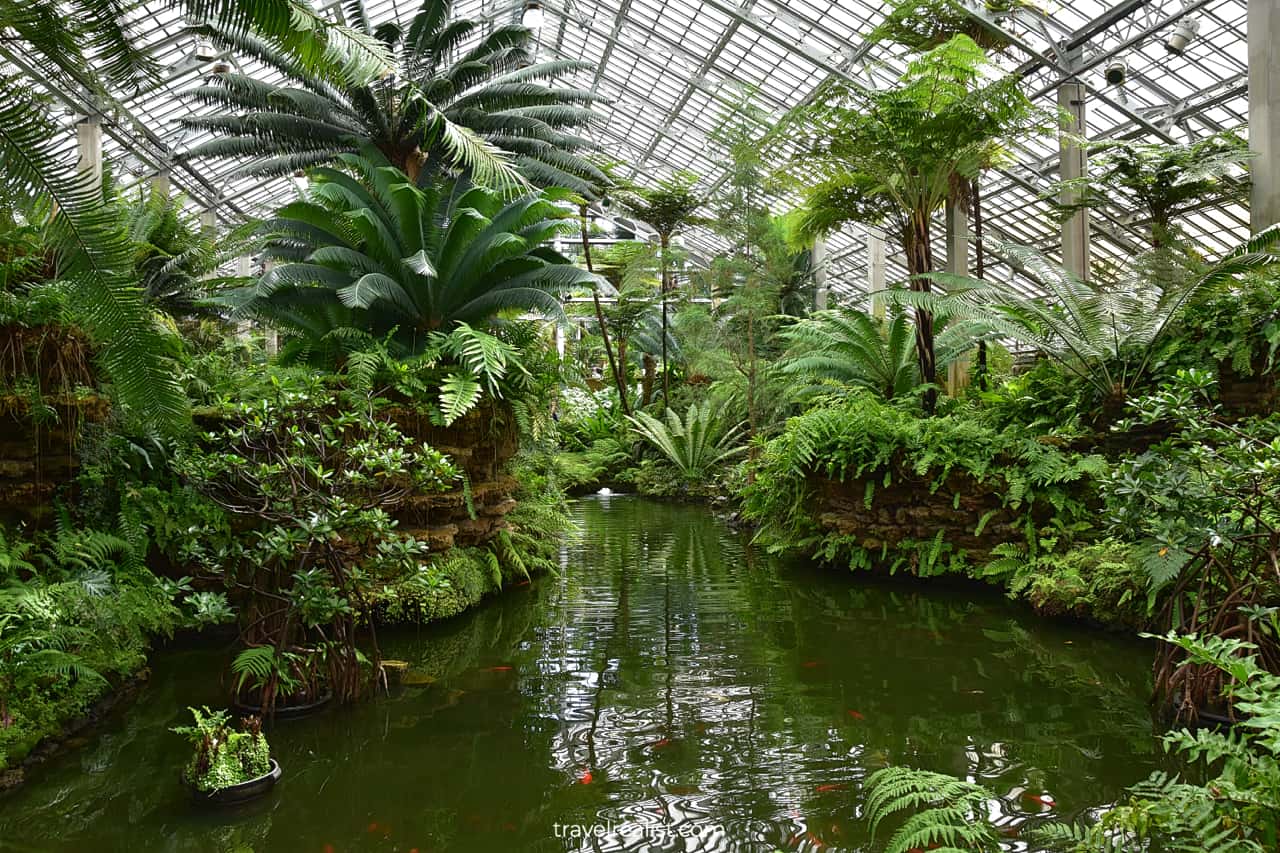
2.2. Waterfall
There is a good reason to have an indoor pond in the Fern Room. Tropical ferns grow best in the high humidity environments.
Instead of constantly watering and misting the plants, you could install a permanent pond. It will accomplish the same result with less ongoing efforts.
There is water almost everywhere in the Fern Room. You will see an artificial waterfall flowing from the wall. Moss and ivy are growing in the constant flow of water.
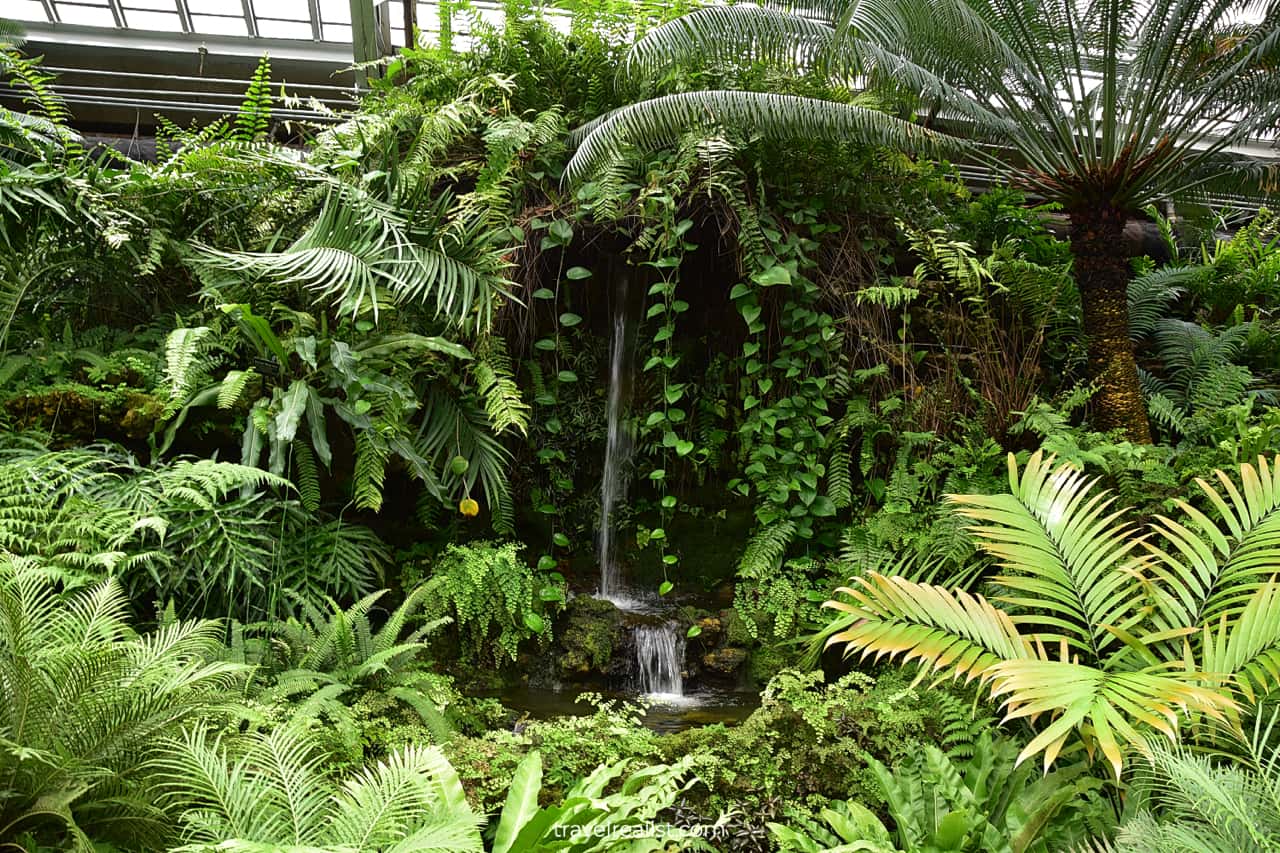
3. Desert House
Once you pass through the doors of the Fern Room, you will find yourself in the Desert House. It looks a bit like a smaller version of the Palm House.
The Desert House is home to a number of drought resistant plants. These plants do not need as much water as ferns to survive. As a result, you will be in a completely different environment.
You are sure to notice a sudden drop in humidity. It is easier to breathe in the Desert House. This room has just about 30% air humidity. Compare it to nearly 90% humidity in the Fern Room.
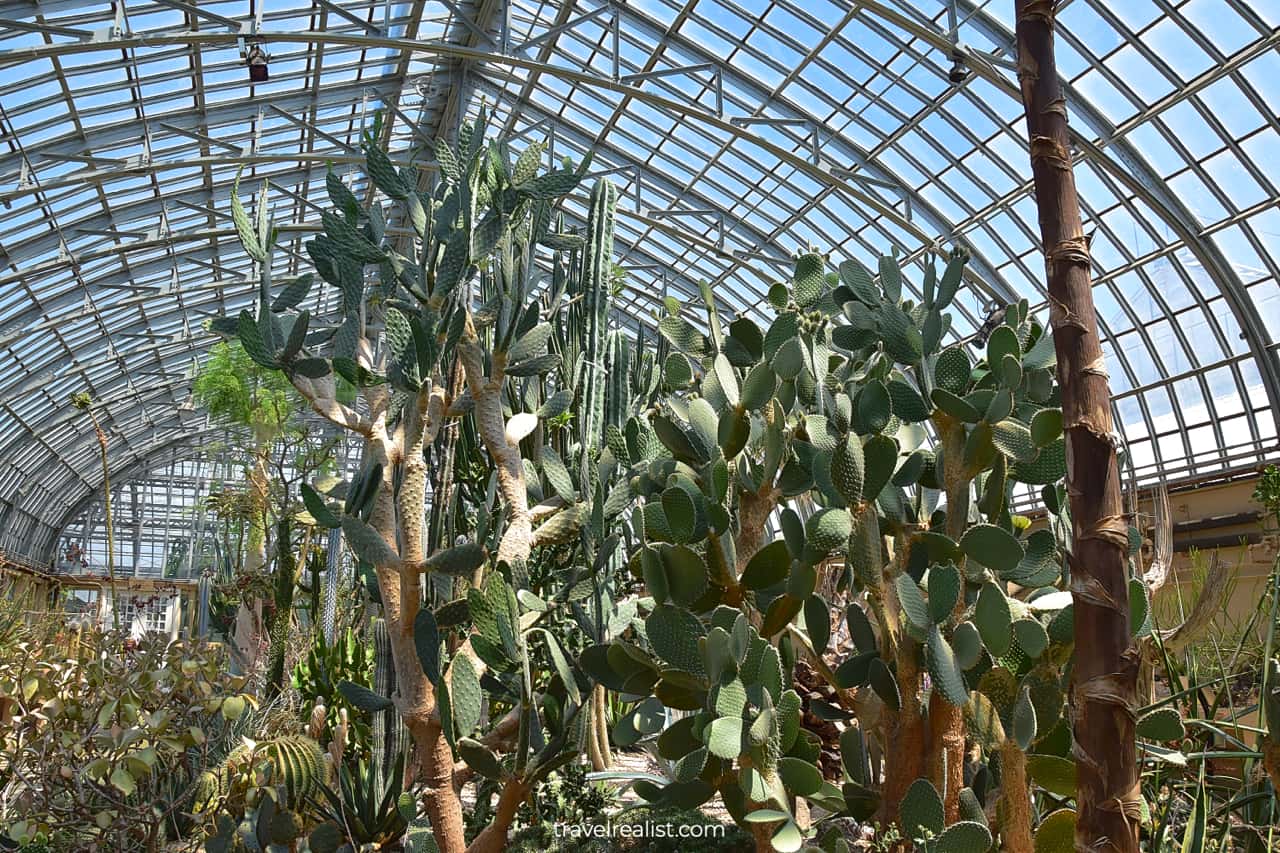
3.1. Cacti
Once you get readjusted to the dry Chicago climate, you could continue your exploration of the Garfield Park Conservatory. There are still plenty of plants to see in the remaining chambers.
Cacti are the first plants one thinks about when someone mentions a desert. There are lots of different cacti in the Garfield Park Conservatory.
They take all possible shapes and forms. Some cacti are tall and almost reach the ceiling. Others look just like Chenille pricklypear cactus in Pedernales Falls State Park in Texas.
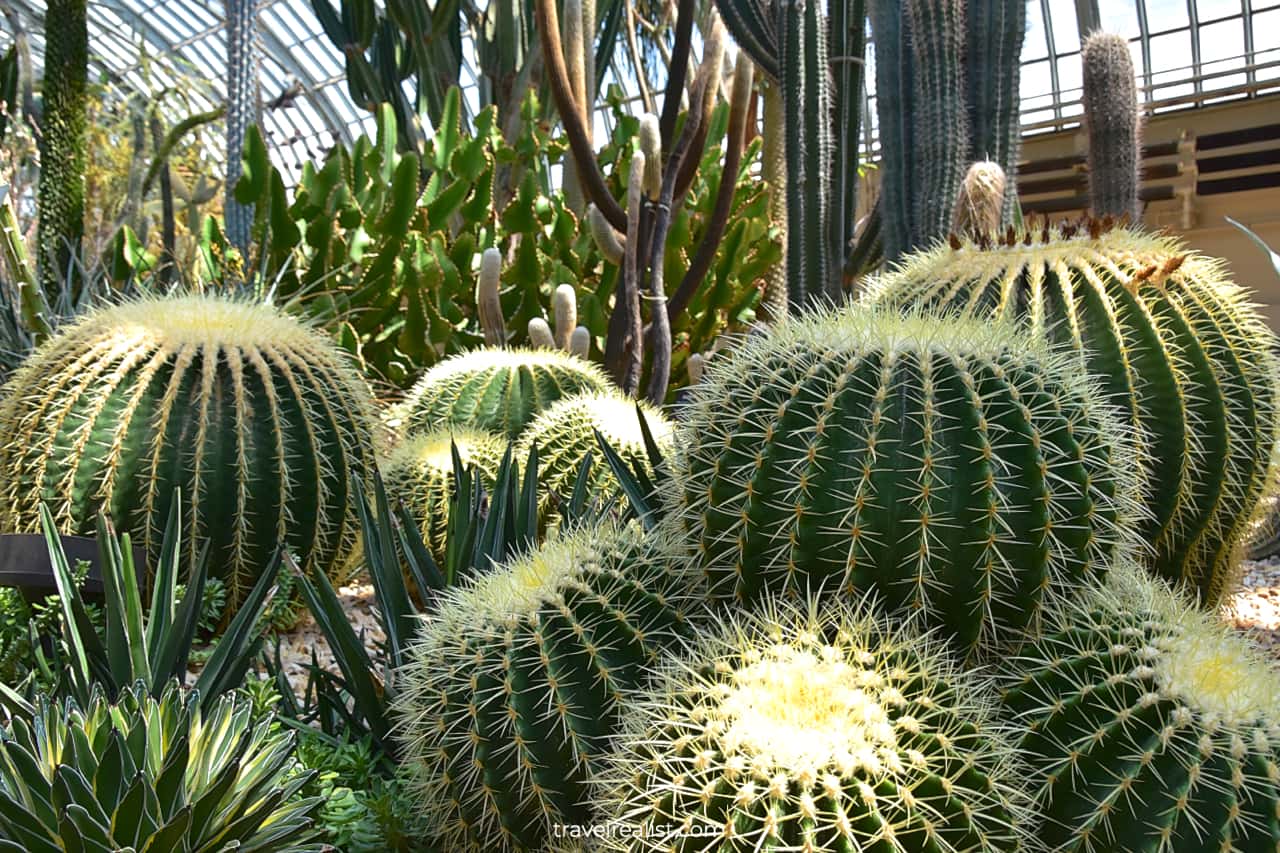
Every plant in the conservatory has a small plaque. It tells you the name of the plant and its origin. It is fascinating how much you could learn from these tiny plaques.
Take Canary Island Spurge as an example. This succulent is a native of Canary Islands in Spain. It does not grow in the wild anywhere else.
You could recreate this learning experience by using Google Lens. This app gives you results based on the image you take. This is a good way to learn about the wild plants around you.
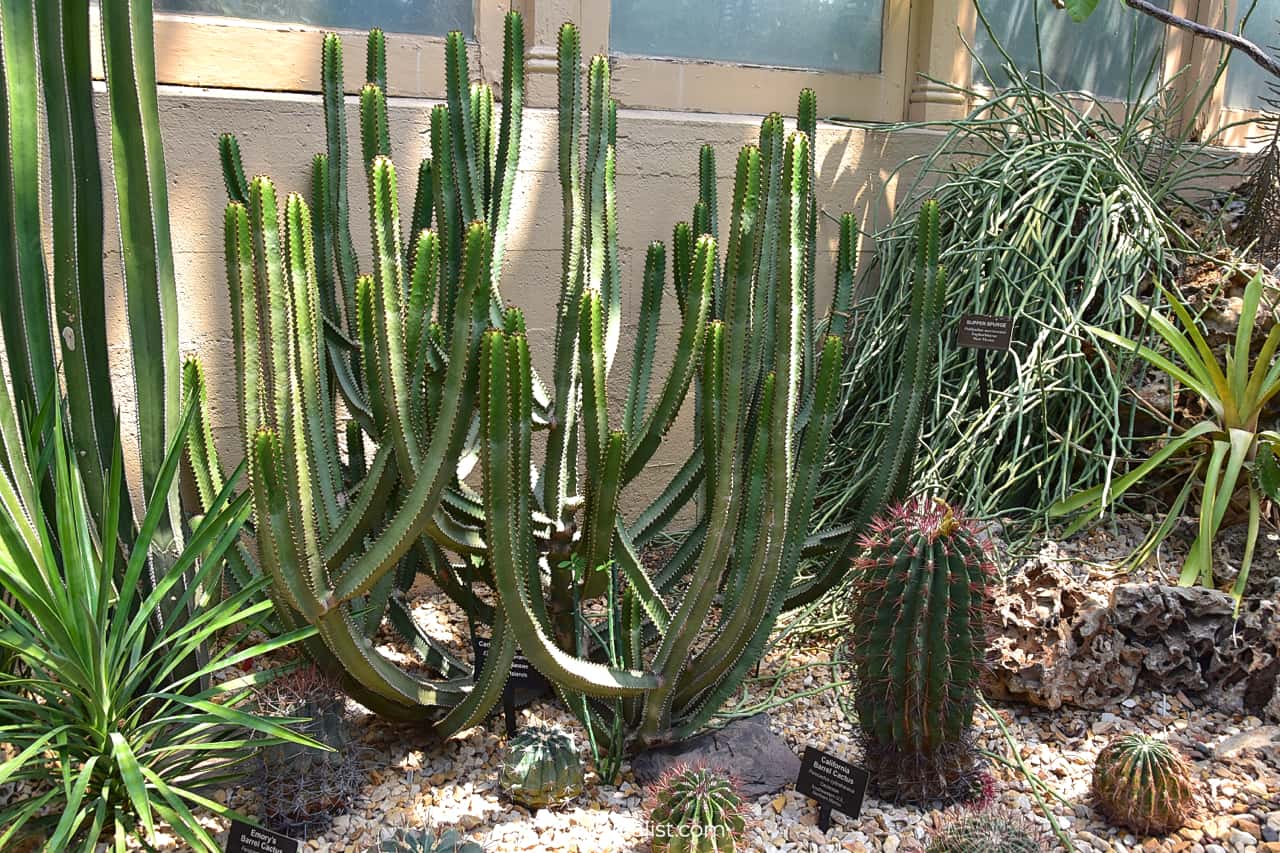
3.2. Desert Rose
As you continue exploring the Desert House, you will move from cacti to succulents. One succulent is certain to catch your attention.
A desert rose is a beautiful succulent shrub. It looks a lot like a Bonsai tree when not in bloom. But this plant transforms once it has flowers. Its tubular flowers have five petals.
Keep in mind that a sap of a desert rose is poisonous. It could cause skin irritation and even kill a pet if ingested. Enjoy this plant from a distance. Wash your hands if you came in contact with a desert rose.
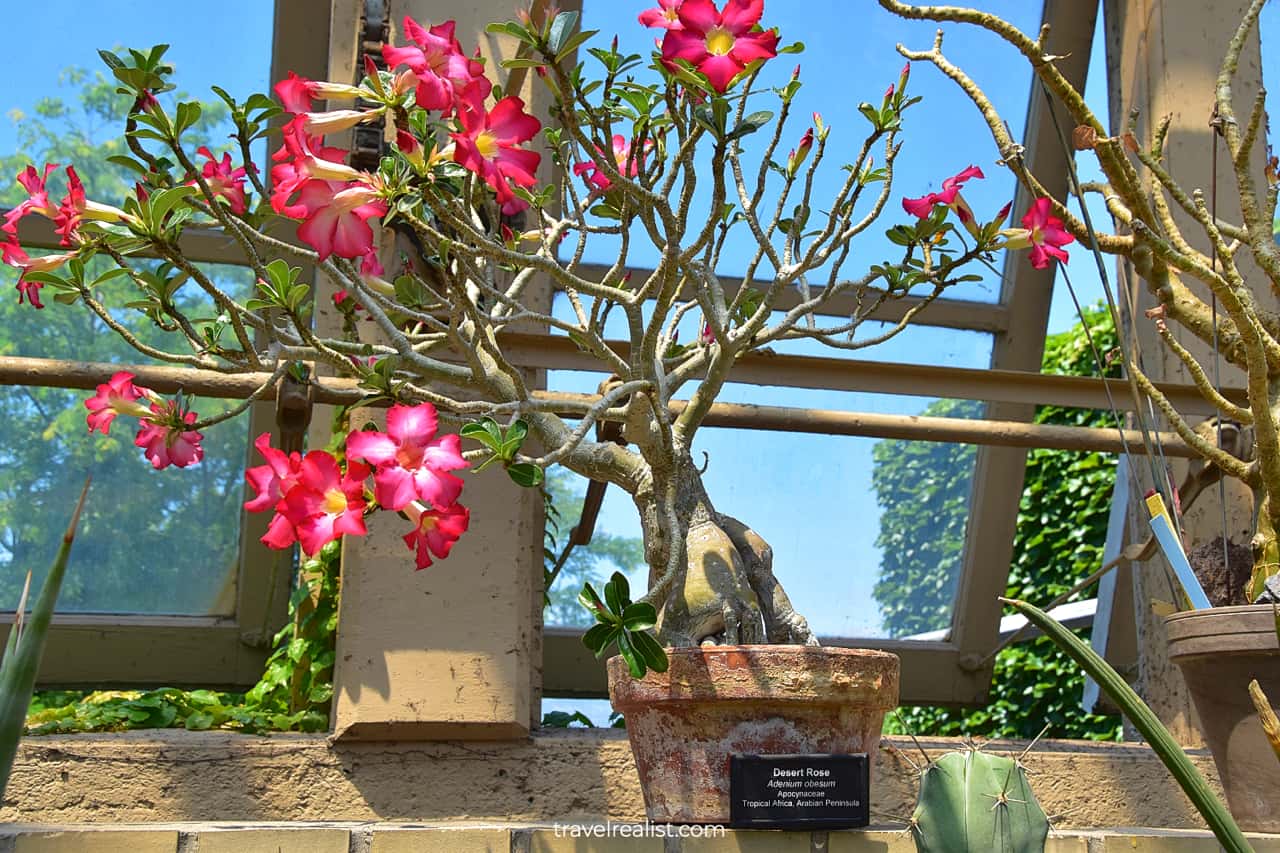
3.3. Succulents
Succulents are another common sight in homes across the world. You could grow succulents fairly easily as long as you do not overwater them.
Succulents take a fair share of space in the greenhouses in the US. The Garfield Park Conservatory in Chicago is no different. It proudly displays beautiful succulents in the Desert House.
But not all succulents are created equal. A handful of them has different forms and shapes. Just take a look at the Living Baseball and Moroccan Mound. Both plants have quite descriptive names and shapes.
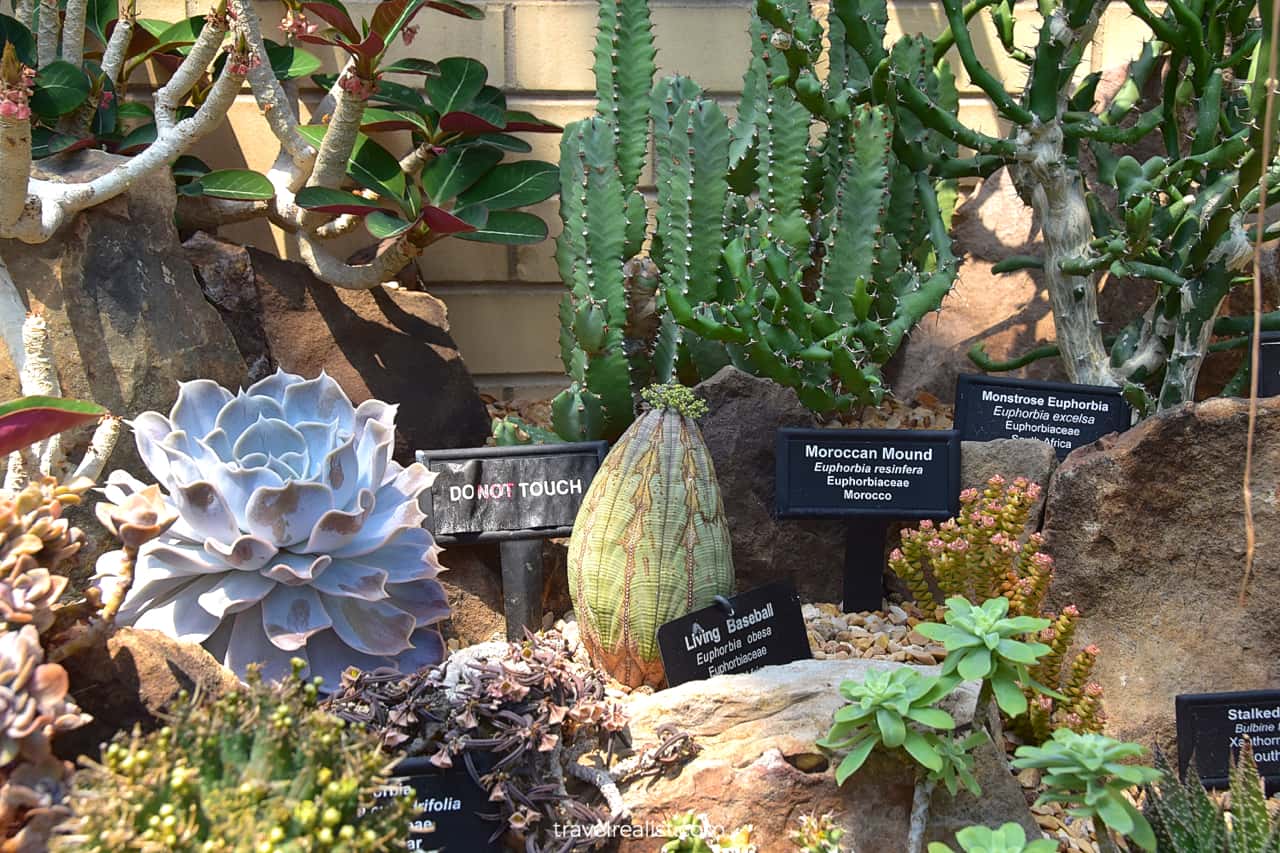
4. Aroid House
The Desert House has four exits. Yet, two of them remain closed most of the time. You cannot go outside to the Bluestone Terrace. The same rule applies to the Children’s Garden.
It means that you have only two options. You could go back to the Fern Room or turn right to the Aroid House. Unless you prefer to see the ferns, pond, and waterfall again, the choice is quite clear.
The Aroid House is a smaller greenhouse than most other chambers in the conservatory. It also has a relatively high humidity level of 60% to 80%.
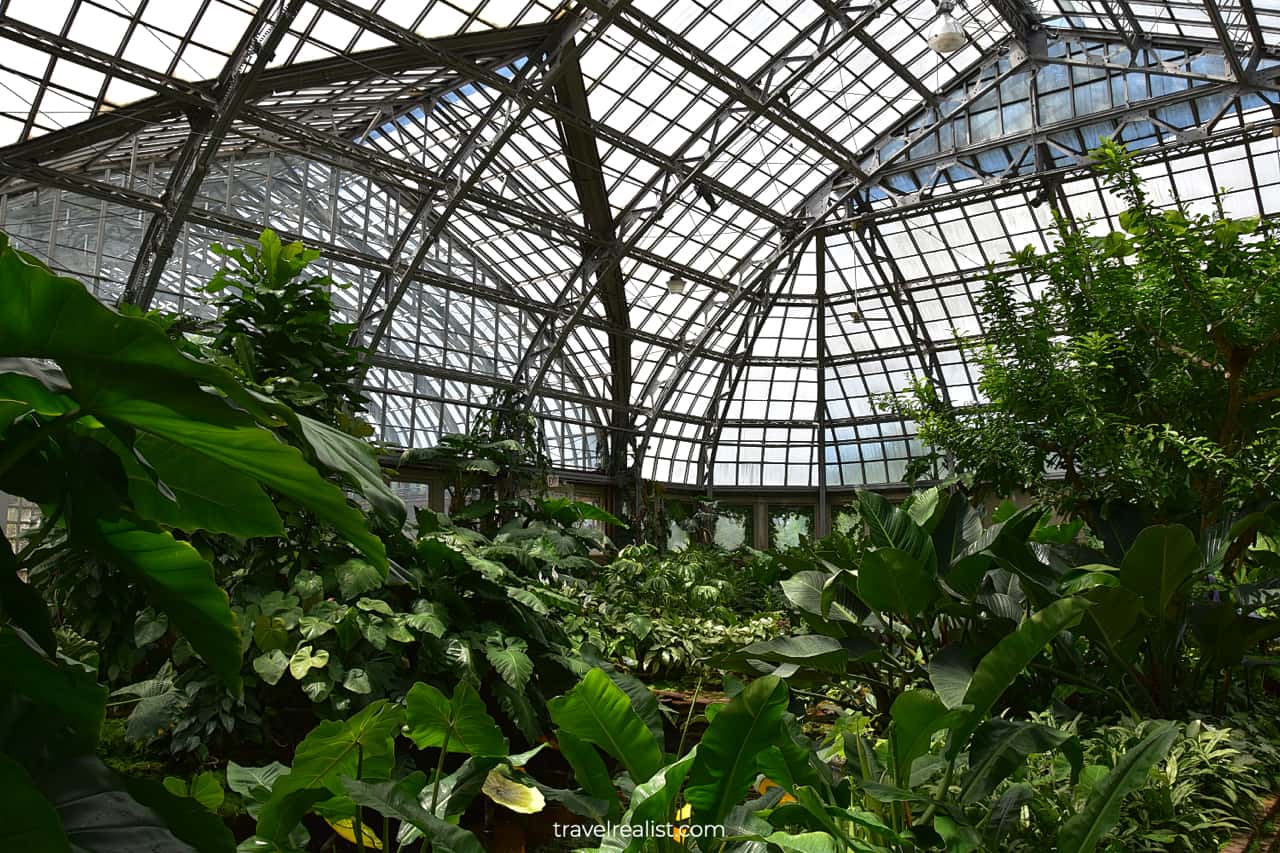
This humidity and temperature conditions are ideal for aroids to thrive. You have likely heard and seen some of the aroids before. In fact, it is possible that you might be growing one at home.
Do the names of Philodendron or Aglaonema sound familiar? Both are the primary examples of aroids. But these two plants are toxic for humans and pets if consumed.
A handful of aroids have beautiful flowers with a spadix. It is quite a sight to see if you visit the Garfield Park Conservatory during the aroid bloom season.
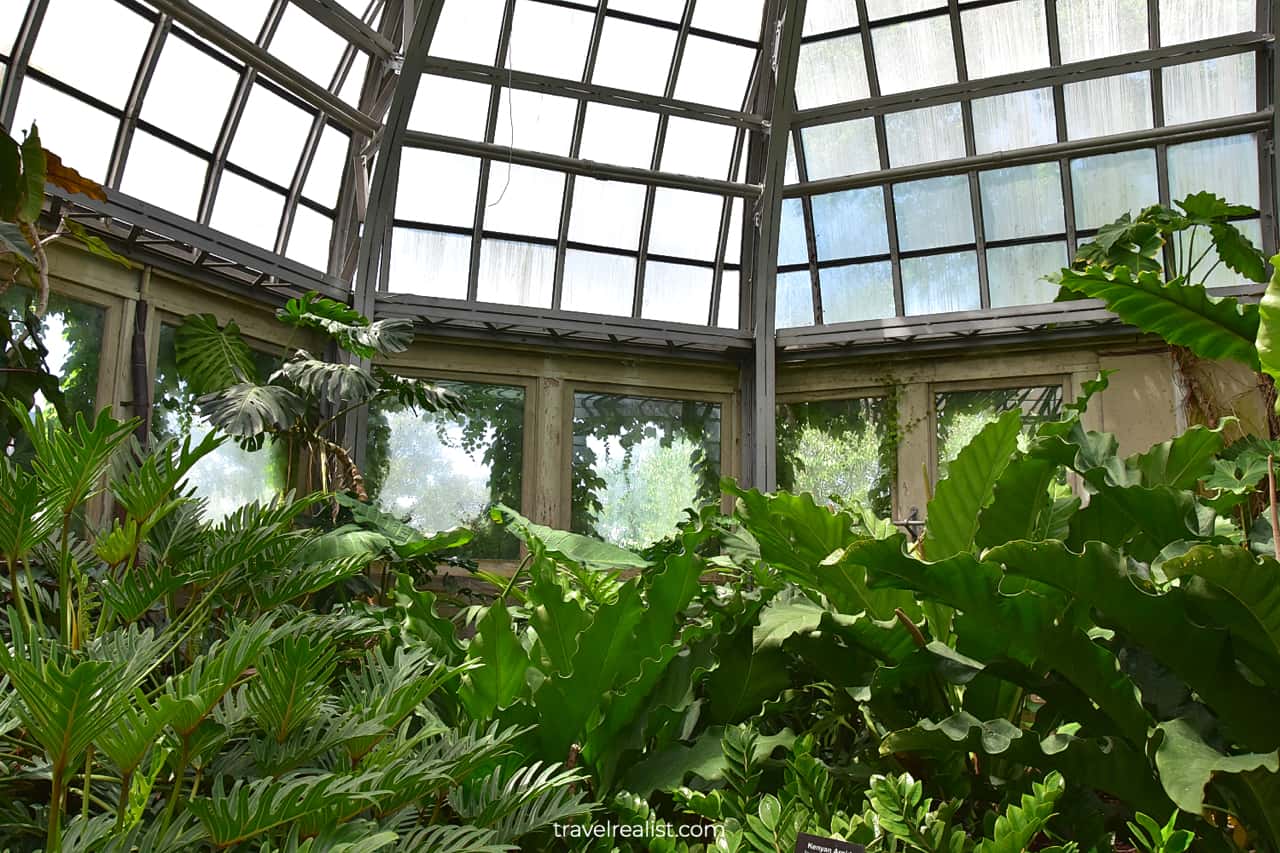
5. Show House
You could return to the Palm House via the Show House. This chamber is home to many seasonal plants. Depending on the time of the year it could be full or nearly empty.
It is hard to say in advance what plants you will see in the Show House. But you could hope to encounter a blooming African Lily.
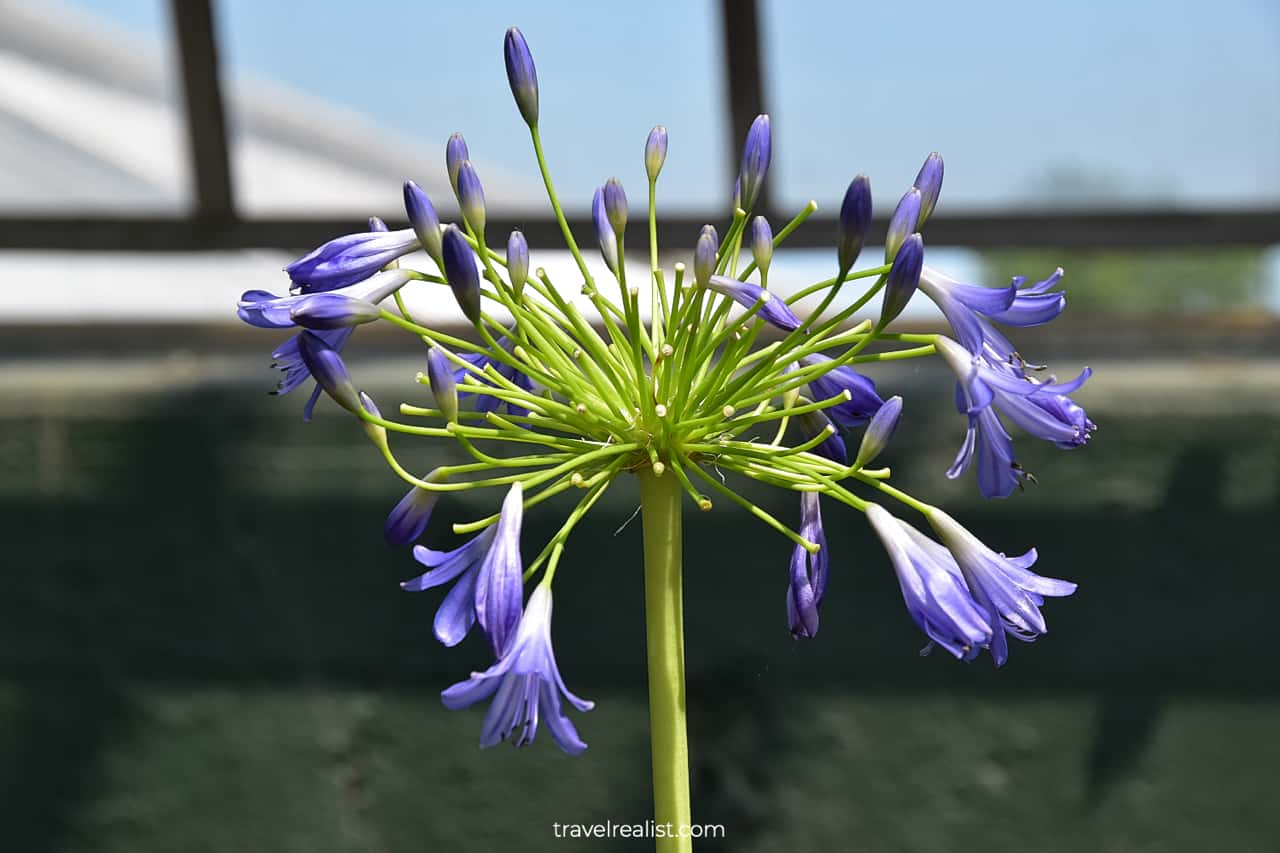
6. Sensory Garden
There are a few more areas for you to explore once you exit the main greenhouse building. Head to the Sensory Garden on the south side of the conservatory.
This Garden is home to a small outdoor pond. There are a few water lilies. You can see them bloom if you visit the Garfield Park Conservatory during the summer months.
You could also enjoy a plant labyrinth next to the Sensory Garden. This living maze attracts couples and families with kids.
You could exit the Sensory Garden into the main outdoor grounds. The Garfield Park Conservatory has fields that are multiple times the size of the greenhouses.
You will find lily pools, mounds, aspens, and sugar maples there. The center field is a city garden. Unless gardening is your thing, this is a good time to finish your visit to the Garfield Park Conservatory.
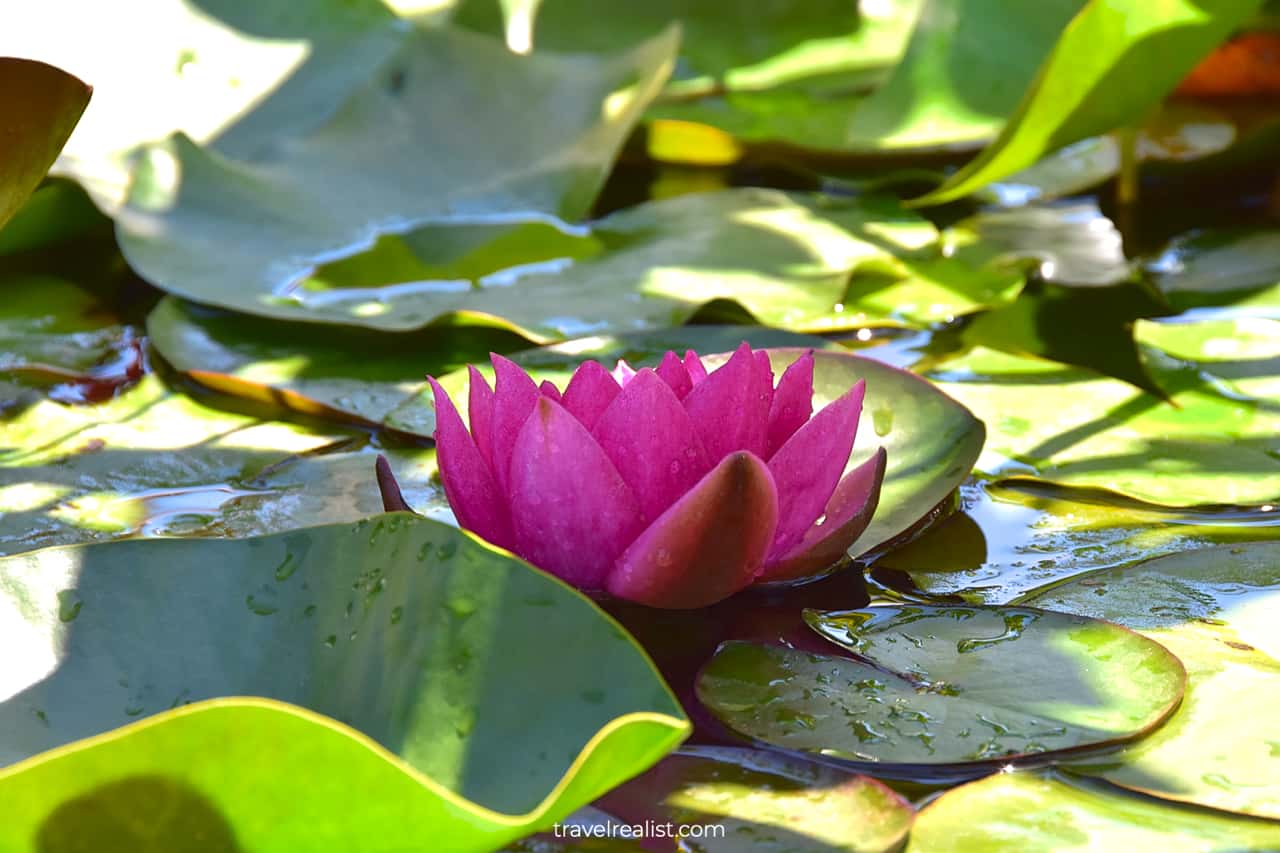
Continue with this Garfield Park Conservatory Guide. You will learn more about ways to get to the sights, entrance requirements, and places to stay.
Getting to Garfield Park Conservatory
The Garfield Park Conservatory is at 300 N Central Park Avenue in Chicago, Illinois. The conservatory is in the northern section of Garfield Park.
It is about halfway between Chicago Loop and Oak Park. This location makes the Garfield Park Conservatory a great addition to a Chicago itinerary for all architecture lovers.
Combine it with the tours of the Frank Lloyd Wright House & Studio and the Ernest Hemingway Birthplace Museum in Oak Park. Or stop by Garfield Park on the way to the Chicago Loop landmarks.
Out-of-state visitors could fly to Chicago Midway (MDW) or Chicago O’Hare (ORD) airports. The former is a hub for Southwest and low cost carriers. O’Hare is a major United hub and main airport of the city.
Both airports are about 60 minutes away on public transport. But it takes slightly less time to reach the conservatory from Midway Airport.
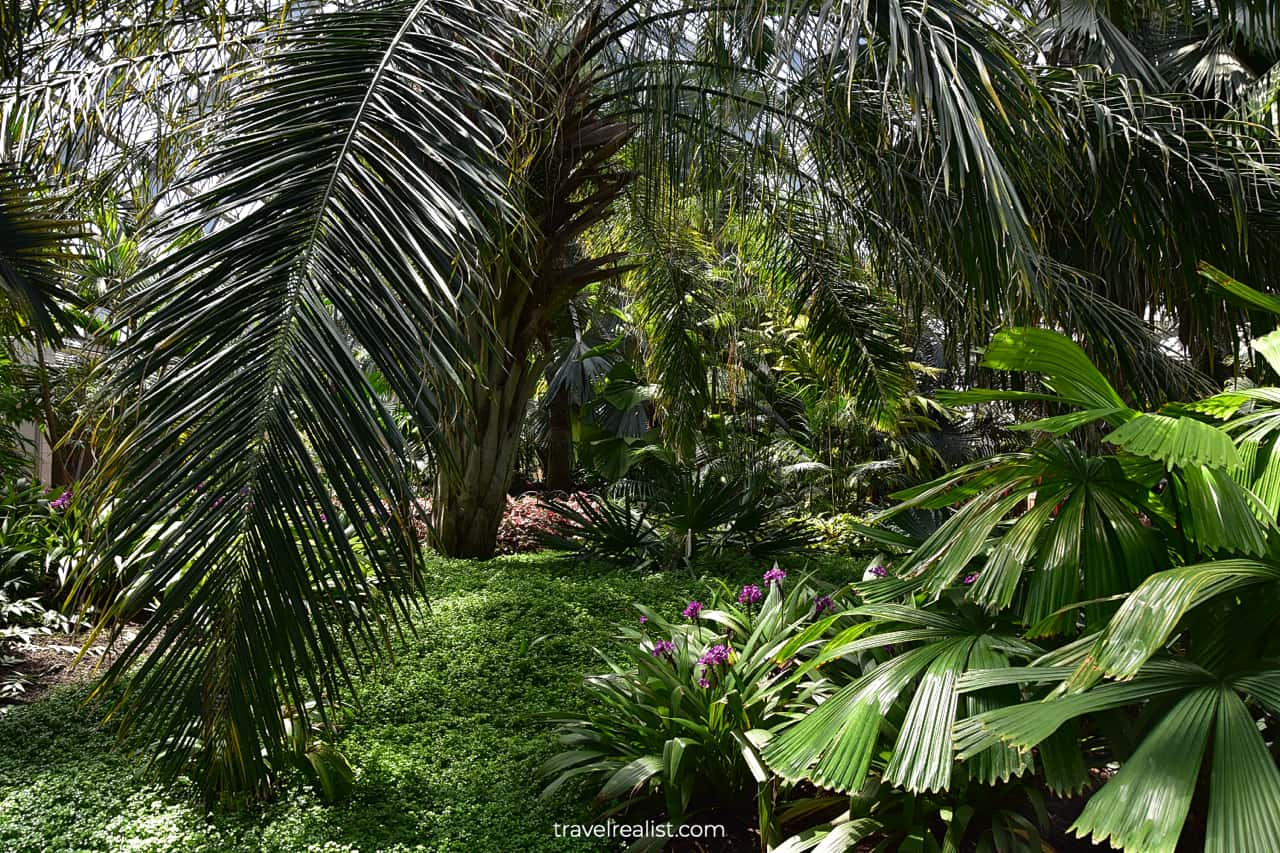
Transportation Options
It is very easy to get to the Garfield Park Conservatory. You could reach it by car, subway, bus, and bike. Here is a cost breakdown of each option.
- Car: free parking at the Visitor Center.
- Subway/L: $2.5 each way or $5 for a day pass.
- Metra Train: $4 each each way or $6 for a day pass.
- Bus: $2.25 each way or $5 for a day pass.
- Bike: $1 + $0.17 per minute or $16.5 for a day pass.
A spacious and free outdoor parking lot is at the intersection of Central Park Avenue and Lake Street. It works best if you visit Garfield Park in your car or rental.
Conservatory-Central Park Drive station is on the Green L line. This station is directly above Lake Street. It provides an easy connection from the Chicago Loop and Woodlawn neighborhoods.
You could be at the Conservatory in under 20 minutes from Millennium Park. A subway ride from the University of Chicago campus is about 45 minutes.
You could also reach the park from a handful of other neighborhoods in the Chicago Metropolitan Area. All you need to do is make a quick line change in the Chicago Loop.
A Metra train gives you another way to visit Garfield Park Conservatory. Exit at Kedzie Station. The Conservatory is a 0.7-mile (1.1-km) walk from the station.
There are few buses that stop near Garfield Park. But you could look into Bus 20 Madison. Still, bus is the least convenient option to reach Garfield Park Conservatory.
A Divvy city bike station is on Central Park Avenue near the car parking lot. This might be the most expensive option depending on your starting location.
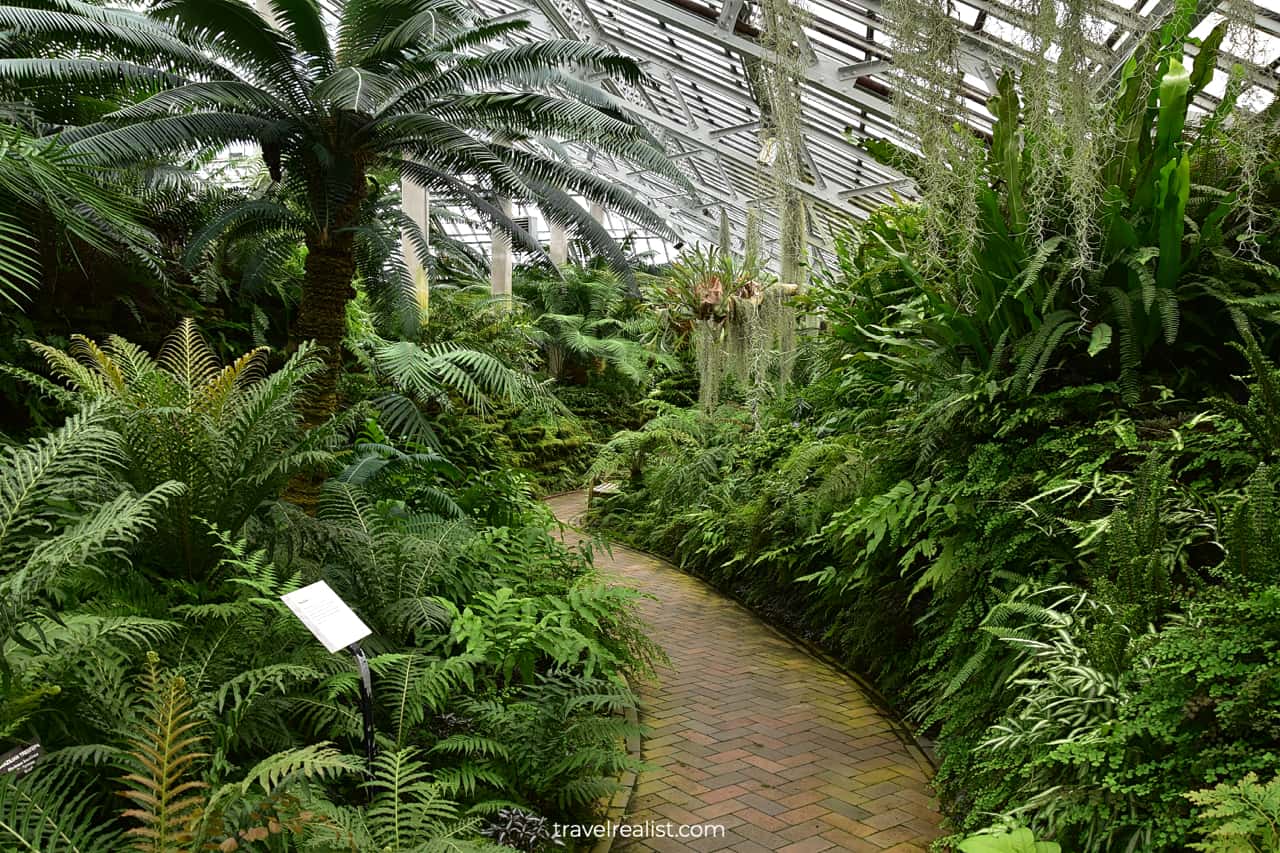
Where to Stay near Garfield Park Conservatory
There are few places to stay within a walking distance from Garfield Park Conservatory. There is a good reason for this development. This part of Chicago gets somewhat rough.
You might be better off looking for a place to stay in other neighborhoods. Chicago Loop has the most selection of places to stay in the entire city.
You will have plenty of lodging options to choose one that works with your requirements. This location also gives you freedom in exploring all the sights in and around Chicago.
Hotel Blake, an Ascend Hotel Collection Member is a great option in the center of action. You will be a walk away from Millenium Park and a short subway ride from the campus and Oak Park.
Parking availability and cost per night are two trade-offs when staying in the Chicago Loop. A location premium and exorbitant parking fees are a reality in this part of town.
You could look into the neighborhoods near the Chicago Loop. SpringHill Suites by Marriott Chicago Chinatown is next to a few L and Metra Lines. So is Hyatt Place Chicago Wicker Park.
You need to venture further away from Loop and Downtown if you plan on exploring Chicago in a rental car. Places to stay in other Chicago neighborhoods do not have such parking constraints.
Oak Brook and Burr Ridge are good options for venturing outside of the city. These towns are on the way to Starved Rock State Park.
There are lots of places to stay near Chicago O’Hare Airport. Schaumburg is another town to consider if you do not mind a longer drive.
Check out Time Out Market Chicago when you get hungry. It is on the same Green Line. You could try dishes from different Chicago restaurants in a glorified food court setting.
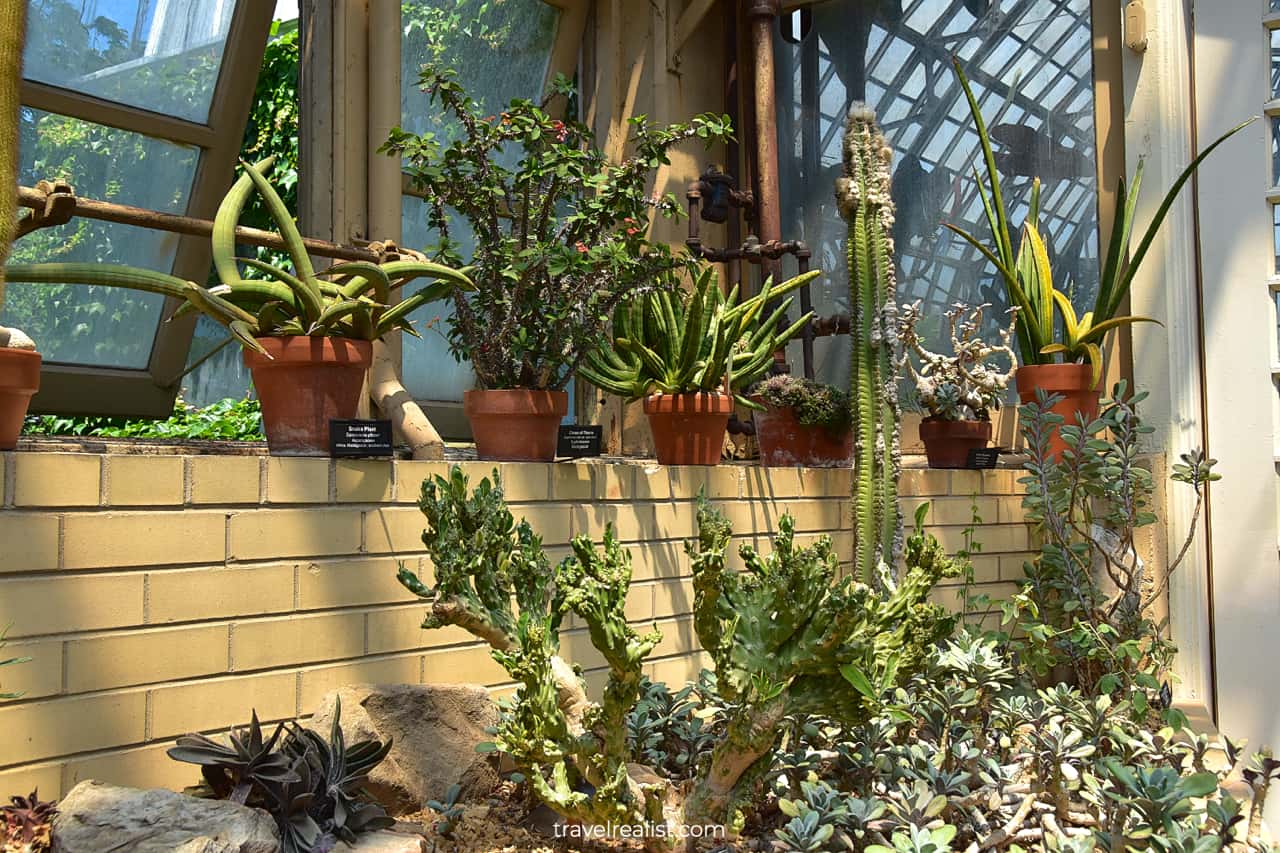
Entrance Requirements & Passes
The Garfield Park Conservatory is open Wednesdays through Sundays. The opening hours depend on the day of the week.
Wednesday has the longest hours, from 10 a.m. to 8 p.m. You could visit the conservatory from 10 a.m. to 5 p.m. on other days. The last admission is an hour before the closing time.
It is free to visit the Garfield Park Conservatory. But you need to get a reservation in advance of your visit. This reservation is also free.
But it allows for conservatory staff to control the visitor count. This ensures a more pleasant experience for all visitors to the Garfield Park Conservatory.
The reservations open 30 days in advance. The conservatory runs out of slots on most weekends and during the summer months.
You could test your luck and try getting a walk-up reservation at the conservatory. In this case, you have a better chance of getting one on a weekday in the winter.
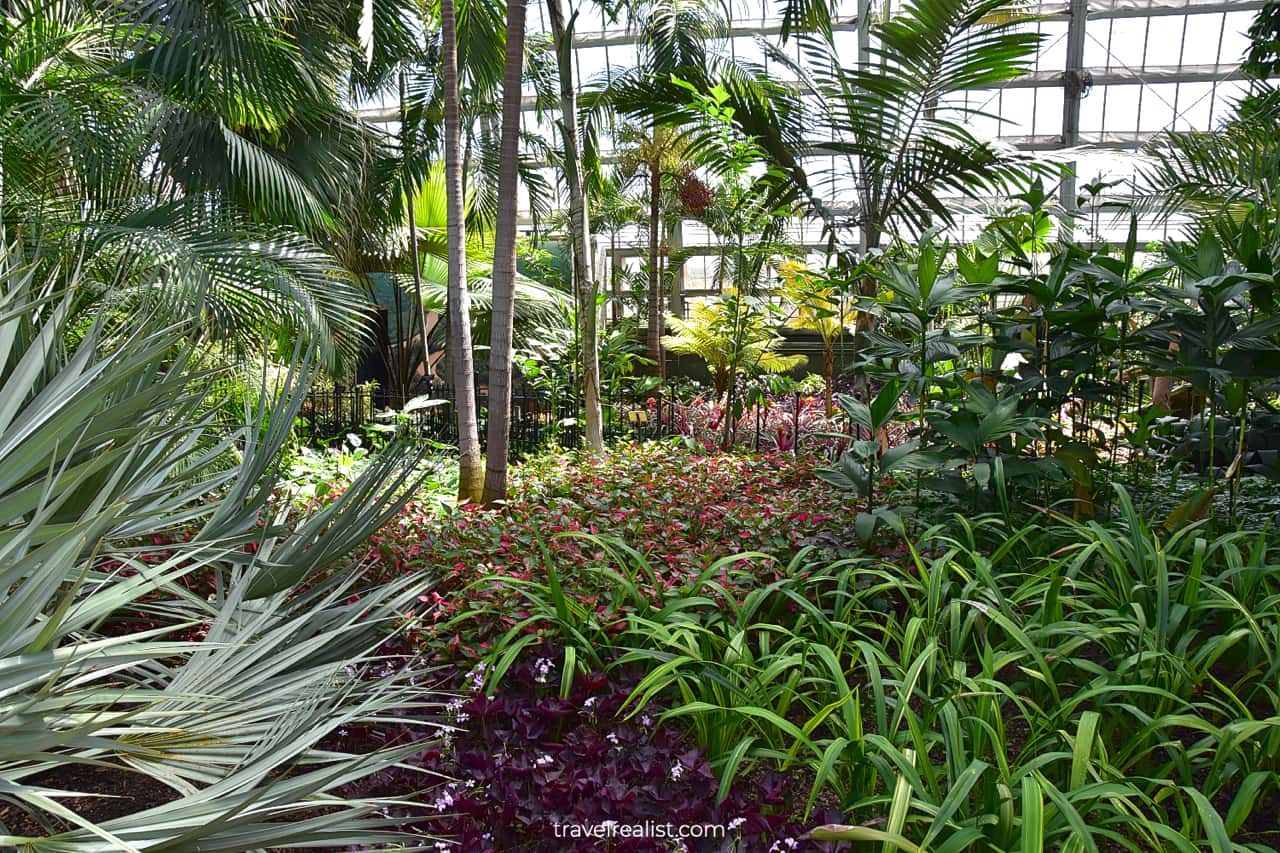
Takeaways: Garfield Park Conservatory Chicago
The Garfield Park Conservatory is a beautiful greenhouse just west of Chicago Loop. It is an excellent stop on a Chicago day trip.
You could easily spend an hour admiring various plants in this massive greenhouse. From Palm House and Fern Room to Desert House and Aroid House, this conservatory has plenty of surprising plants.
You might be able to see some of the plants in other places or even as house plants. But you would need to travel long and wide to enjoy a similar floral collection.
Calathea and Living Baseball, Aroid and Flaming Sword Bromeliad make a visit to the Garfield Park Conservatory worth the time. You are sure to find a few other plants that will appeal to you even more.
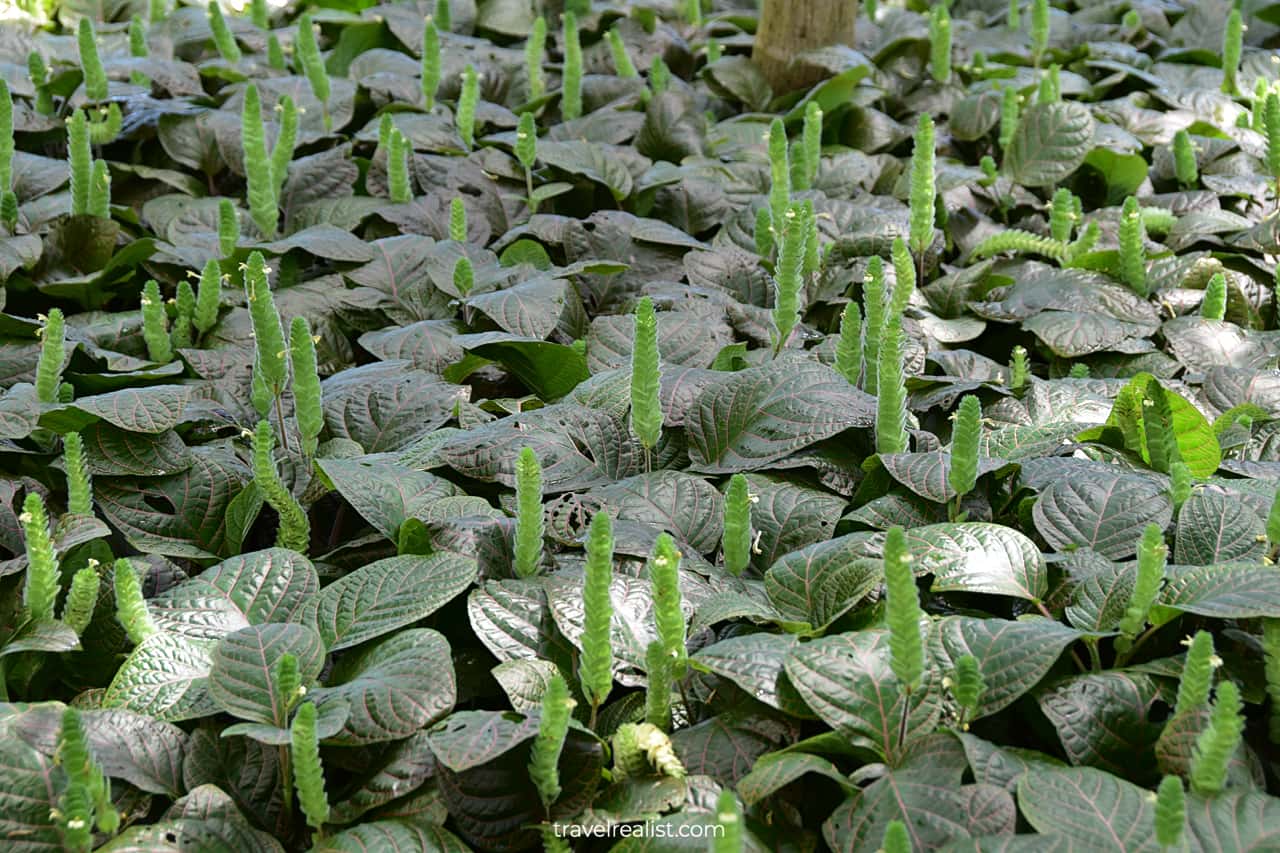
Do not postpone planning a trip to the Garfield Park Conservatory. It is free to visit but you need an advance reservation. The reservation window opens on a 30 day rolling basis.
Pair a visit to this conservatory with the architectural tours in Chicago Loop or Oak Park. This way, you could admire the stunning beauty of both architecture and nature.
You could enjoy this conservatory even if you have a black thumb. But if you have no interest in plants and nature, you will not find this location nearly as interesting.
There is another reason to skip the Garfield Park Conservatory. The area around Garfield Park leaves much to be desired.
You should be relatively safe during a visit to the conservatory. But you should try to only go there during the daylight. Walking in Garfield Park past sunset is a way to get in trouble.
Take a look at this Video List of the Best Places to Visit in and near Chicago. And visit the YouTube channel for the latest videos.
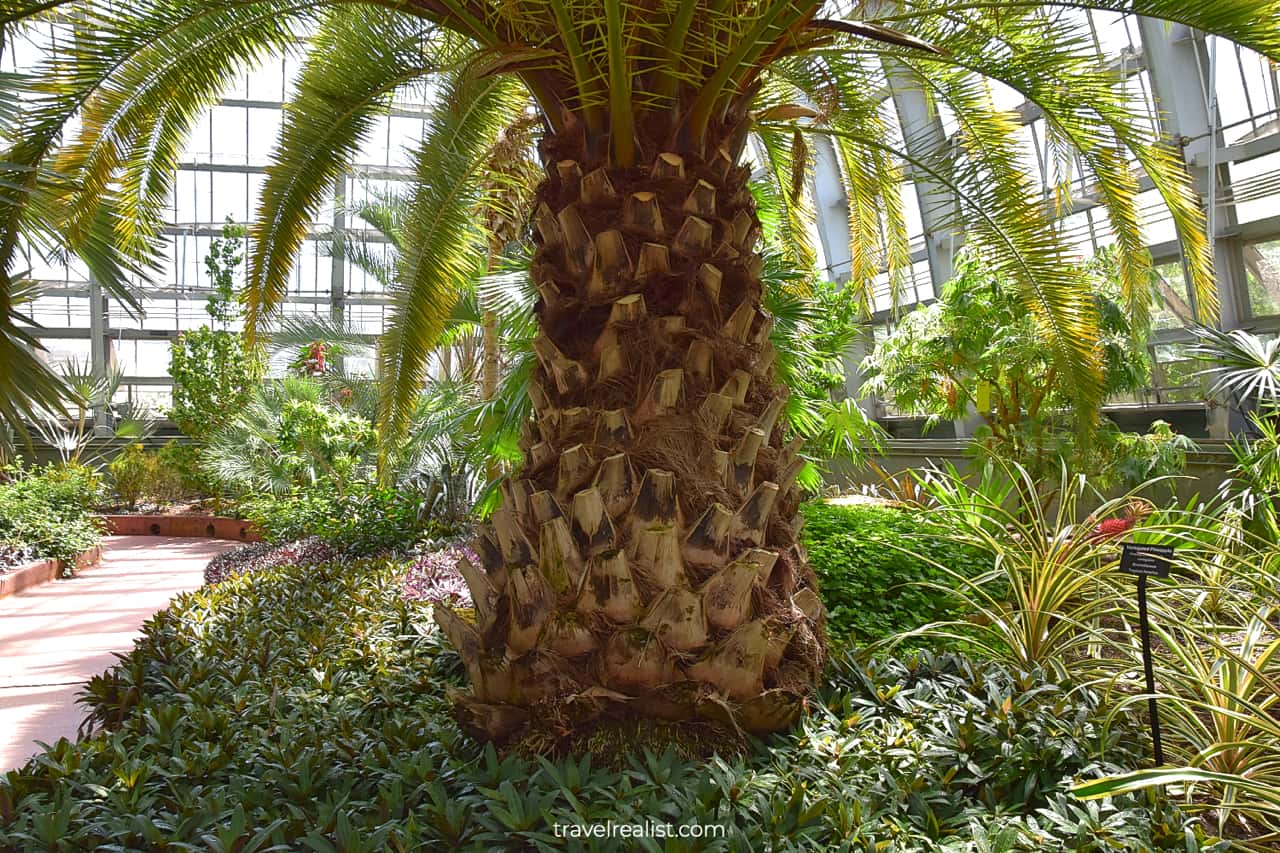
Frequently Asked Questions
You count on spending at least an hour in Garfield Park Conservatory if you enjoy exotic plants. With four major greenhouses open to visitors, there are plenty of plants to see.
You could reach Garfield Park Conservatory by car, subway, train, bus, and bike.
– Car: take your car to the free parking lot at Lake Street and Central Park Avenue.
– Subway/L: board Green Line train to Conservatory-Central Park Drive station.
– Train: board Union Pacific West train to Kedzie station and walk 0.7 miles west.
– Bus: take Bus 20 from Michigan Avenue to Madison & Central Park stop.
– Bike: hop on a Divvy classic or electric bike and park next to the conservatory.
All options are viable for getting to Garfield Park Conservatory. But a car and subway are the easiest ones.
Garfield park Conservatory in Chicago dates back to 1907. It was built as the largest single roof greenhouse in the world.
Garfield Park Conservatory is in East Garfield Park neighborhood of Chicago. It is largely a working class community. Sadly, this community and its neighboring West Garfield Park have some of the highest crime rates in Chicago.
Garfield Park Conservatory in Chicago was constructed in 1907. It has been open to public since 1908.
Garfield Park Conservatory is home to lots of exotic plants. You could find tropical plants in the Palm House, Aroid House, and Fern Room. Expect palm trees, bromeliads, and lilies in these greenhouses. The Desert House has different cacti, succulents, and desert roses.
Safe realist travels!


